Olafur Eliasson
Your lost lighthouse, 2020
lighthouse lens (dated ca. 1900), colour-effect filter cylinder, halogen light bulb, fluorescent light, brass, steel, ballast
218 × ø 29 cm
85 7/8 × ø 11 3/8 inches
“They all live in Berlin, still a city of artists, and the selected works all point indirectly at the repercussions of our current situation.” –Thomas Demand
The exhibition local talent curated by Thomas Demand features more than twenty Berlin based artists, from several generations, diverse nationalities and backgrounds. Their works have either been created in the last few months, or they constitute past concepts for future works that resonate with this unprecedented time.
Permanently emitting an SOS signal in Morse code, Olafur Eliasson’s Your lost lighthouse (2020) reverses the function of the lighthouse by becoming the object in distress. Rather than the guiding light to any number of ships in stormy seas, the rainbow-tinged flashes indicate unknown troubles from within. A prism-like casing looks more organic than mechanical, allowing the light to refract from its New Zealand sourced antique lens across the space.
Olafur Eliasson
Your lost lighthouse, 2020
lighthouse lens (dated ca. 1900), colour-effect filter cylinder, halogen light bulb, fluorescent light, brass, steel, ballast
218 × ø 29 cm
85 7/8 × ø 11 3/8 inches
Olafur Eliasson
Your lost lighthouse, 2020
lighthouse lens (dated ca. 1900), colour-effect filter cylinder, halogen light bulb, fluorescent light, brass, steel, ballast
218 × ø 29 cm
85 7/8 × ø 11 3/8 inches
Permanently emitting an SOS signal in Morse code, Olafur Eliasson’s Your lost lighthouse (2020) reverses the function of the lighthouse by becoming the object in distress. Rather than the guiding light to any number of ships in stormy seas, the rainbow-tinged flashes indicate unknown troubles from within. A prism-like casing looks more organic than mechanical, allowing the light to refract from its New Zealand sourced antique lens across the space.
In its depiction of a romanticized sky, Miriam Böhm’s Only 1 (2019–20) resonates in our pandemic-tinged era, with allusions to boundless travel and space that is no longer available. The framed photograph with one segment missing is hung over another strip of wallpapered sky, producing a collage effect of an image within another image. The layered, disjointed effect instills a feeling of disquiet in an otherwise seemingly beautiful scene.

Miriam Böhm
Only 1, 2019–20
Ditone Print and Wallpaper Print
134 × 110 cm (entire installation)
75 × 100 cm (framed photography)
52 3/4 × 43 1/4 inches (entire installation)
29 1/2 × 39 3/8 inches (framed photography)
Edition of 4 +2 AP

Miriam Böhm
Only 1, 2019–20
Ditone Print and Wallpaper Print
134 × 110 cm (entire installation)
75 × 100 cm (framed photography)
52 3/4 × 43 1/4 inches (entire installation)
29 1/2 × 39 3/8 inches (framed photography)
Edition of 4 +2 AP
Miriam Böhm
Only 1, 2019–20
Ditone Print and Wallpaper Print
134 × 110 cm (entire installation)
75 × 100 cm (framed photography)
52 3/4 × 43 1/4 inches (entire installation)
29 1/2 × 39 3/8 inches (framed photography)
Edition of 4 +2 AP

Miriam Böhm
Only 2, 2019–20
Ditone Print and Wallpaper Print
107 × 97 cm (entire installation)
65 × 90 cm (framed photography)
42 1/8 × 38 1/8 inches
25 5/8 × 35 3/8 inches
Edition of 4 +2 AP

Miriam Böhm
Only 2, 2019–20
Ditone Print and Wallpaper Print
107 × 97 cm (entire installation)
65 × 90 cm (framed photography)
42 1/8 × 38 1/8 inches
25 5/8 × 35 3/8 inches
Edition of 4 +2 AP
Miriam Böhm
Only 2, 2019–20
Ditone Print and Wallpaper Print
107 × 97 cm (entire installation)
65 × 90 cm (framed photography)
42 1/8 × 38 1/8 inches
25 5/8 × 35 3/8 inches
Edition of 4 +2 AP
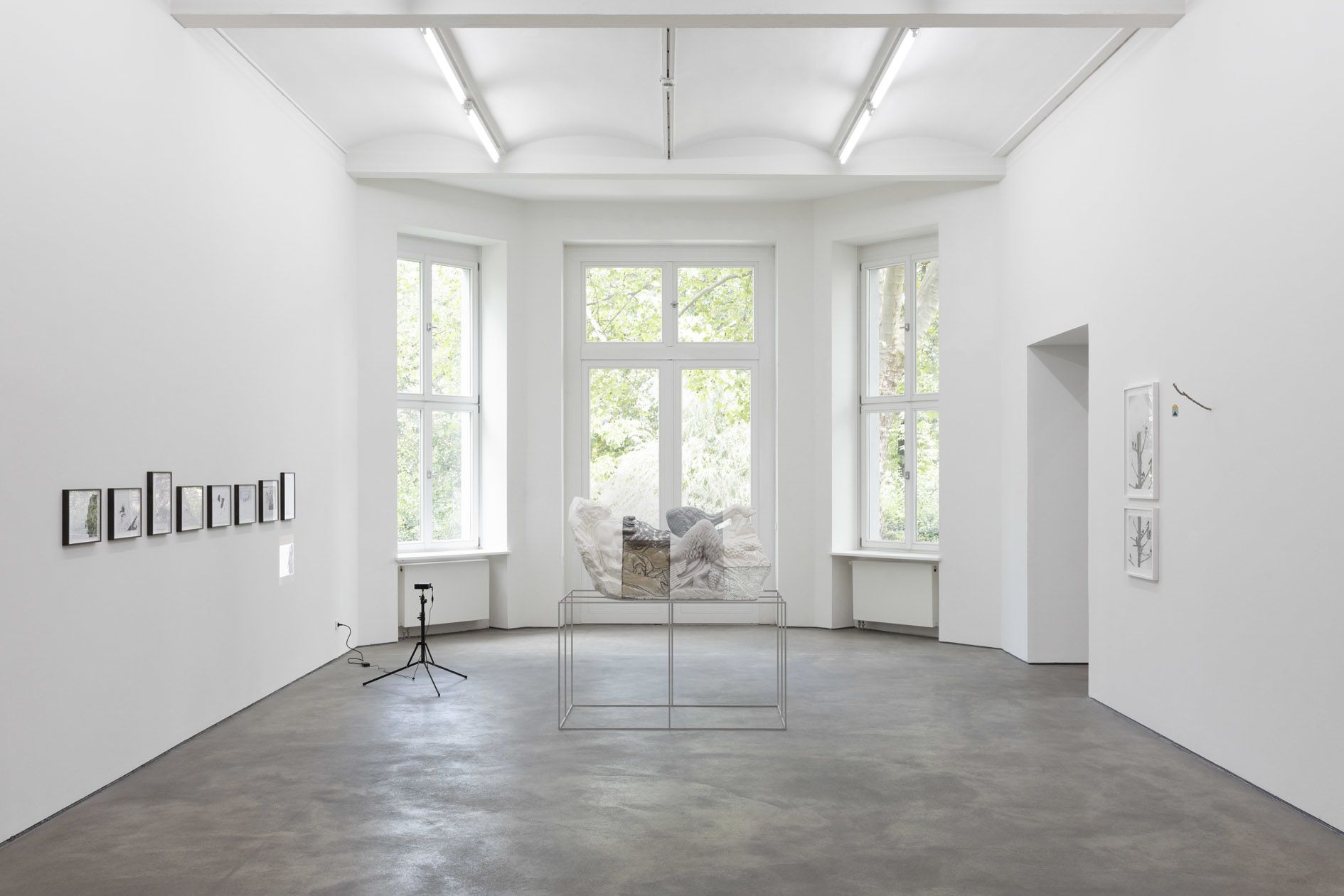

Oliver Laric
Reclining Pan, 2019
Stereolithography, selective laser sintering, polyamide, polyurethane, pigments, aluminum base
145.7 × 151.7 × 83.7 cm
57 3/8 × 59 3/4 × 33 inches

Oliver Laric
Reclining Pan, 2019
Stereolithography, selective laser sintering, polyamide, polyurethane, pigments, aluminum base
145.7 × 151.7 × 83.7 cm
57 3/8 × 59 3/4 × 33 inches

Saint Louis Museum, attributed to Francesco da Sangallo
A remake of a renaissance sculpture from the St Louis Art Museum, Oliver Laric’s Reclining Pan (2019) depicts the half-goat half-man god of the woods, known for his mischievousness and carnality. The fragmented vision, comprised of several 3D printed components in different materials, asks questions about the nature of facsimiles and copies, engaging with ideas of authorship and appropriation for a post-internet generation. This generation will also find answers to the growing limitations in proliferating their artworks globally. According to the artist, objects may become interchangeable as long as their concepts are floating worldwide.

Oliver Laric
Reclining Pan, 2019
Stereolithography, selective laser sintering, polyamide, polyurethane, pigments, aluminum base
145.7 × 151.7 × 83.7 cm
57 3/8 × 59 3/4 × 33 inches
Oliver Laric
Reclining Pan, 2019
Stereolithography, selective laser sintering, polyamide, polyurethane, pigments, aluminum base
145.7 × 151.7 × 83.7 cm
57 3/8 × 59 3/4 × 33 inches


Oliver Laric
Reclining Pan, 2019
Stereolithography, selective laser sintering, polyamide, polyurethane, pigments, aluminum base
145.7 × 151.7 × 83.7 cm
57 3/8 × 59 3/4 × 33 inches


Saint Louis Museum, attributed to Francesco da Sangallo
A remake of a renaissance sculpture from the St Louis Art Museum, Oliver Laric’s Reclining Pan (2019) depicts the half-goat half-man god of the woods, known for his mischievousness and carnality. The fragmented vision, comprised of several 3D printed components in different materials, asks questions about the nature of facsimiles and copies, engaging with ideas of authorship and appropriation for a post-internet generation. This generation will also find answers to the growing limitations in proliferating their artworks globally. According to the artist, objects may become interchangeable as long as their concepts are floating worldwide.
The nesting pigeons of Anri Sala’s Voladores (Flyers) (2020) are shown in their adopted home of the zoo in the artist’s native Tirana, where the birds settled after the site was abandoned. The pigeons have purposefully moved into a new form of captivity, their loss of mobility perhaps reflective of our current predicament. Within the current context the notion of a self-governing migration of species gets a very poignant twist, considering the origin of the virus.

Anri Sala
Voladores, 2020
Black and white photograph on baryte paper, mounted on dibond, 2 parts
70 × 50,2 cm; 42,5 × 50,2 cm
27 5/8 × 19 3/4 in; 16 3/4 × 19 3/4 in
Edition of 5 + 2 AP

Anri Sala
Voladores, 2020
Black and white photograph on baryte paper, mounted on dibond, 2 parts
70 × 50,2 cm; 42,5 × 50,2 cm
27 5/8 × 19 3/4 in; 16 3/4 × 19 3/4 in
Edition of 5 + 2 AP

Anri Sala
Voladores, 2020
Black and white photograph on baryte paper, mounted on dibond, 2 parts
70 × 50,2 cm; 42,5 × 50,2 cm
27 5/8 × 19 3/4 in; 16 3/4 × 19 3/4 in
Edition of 5 + 2 AP

Anri Sala
Voladores, 2020 (detailf)
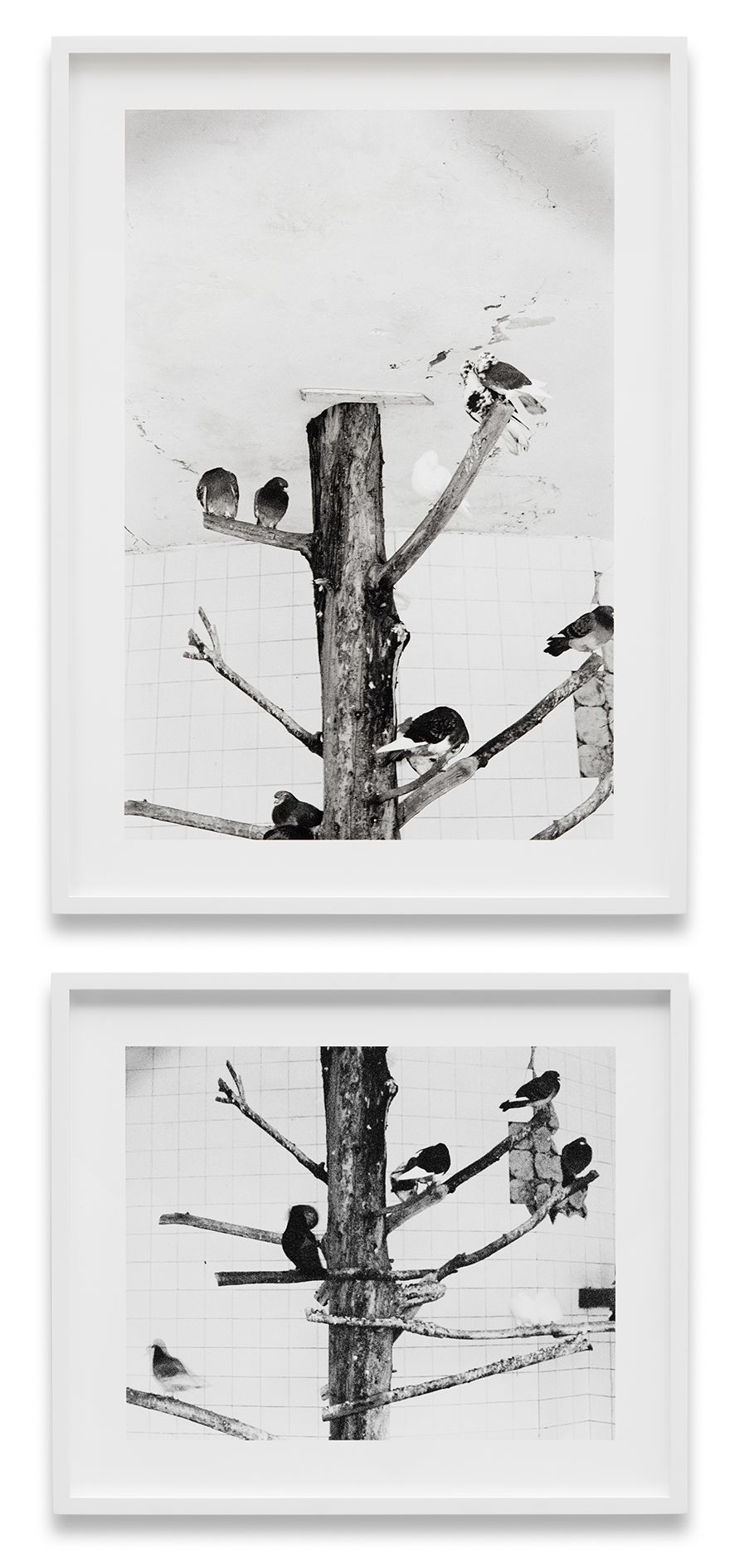
Anri Sala
Voladores, 2020
Black and white photograph on baryte paper, mounted on dibond, 2 parts
70 × 50,2 cm; 42,5 × 50,2 cm
27 5/8 × 19 3/4 in; 16 3/4 × 19 3/4 in
Edition of 5 + 2 AP
Anri Sala
Voladores, 2020
Black and white photograph on baryte paper, mounted on dibond, 2 parts
70 × 50,2 cm; 42,5 × 50,2 cm
27 5/8 × 19 3/4 in; 16 3/4 × 19 3/4 in
Edition of 5 + 2 AP


Anri Sala
Voladores, 2020
Black and white photograph on baryte paper, mounted on dibond, 2 parts
70 × 50,2 cm; 42,5 × 50,2 cm
27 5/8 × 19 3/4 in; 16 3/4 × 19 3/4 in
Edition of 5 + 2 AP


Anri Sala
Voladores, 2020
Black and white photograph on baryte paper, mounted on dibond, 2 parts
70 × 50,2 cm; 42,5 × 50,2 cm
27 5/8 × 19 3/4 in; 16 3/4 × 19 3/4 in
Edition of 5 + 2 AP


Anri Sala
Voladores, 2020 (detailf)
The nesting pigeons of Anri Sala’s Voladores (Flyers) (2020) are shown in their adopted home of the zoo in the artist’s native Tirana, where the birds settled after the site was abandoned. The pigeons have purposefully moved into a new form of captivity, their loss of mobility perhaps reflective of our current predicament. Within the current context the notion of a self-governing migration of species gets a very poignant twist, considering the origin of the virus.

Mathew Hale
One Silver Dollar Painting (August 12, 2018), 2018
Price tag, acrylic paint, color 3D print, silver ink
20 × 22 × 8 cm
7 7/8 × 8 5/8 × 3 1/8 inches
Mathew Hale’s One Silver Dollar Paintings series, begun in 2016, is part of a process the artist undertakes in which he photographs both sides of Marilyn Monroe’s place of burial in Westwood, Los Angeles – both the mausoleum building, with her plaque of remembrance, and the nondescript white wall of the car park behind. In the image Hale also includes a small painting on a price tag as a means of identification.

Mathew Hale
One Silver Dollar Painting (August 12, 2018), 2018
Price tag, acrylic paint, color 3D print, silver ink
20 × 22 × 8 cm
7 7/8 × 8 5/8 × 3 1/8 inches
Mathew Hale
One Silver Dollar Painting (August 12, 2018), 2018
Price tag, acrylic paint, color 3D print, silver ink
20 × 22 × 8 cm
7 7/8 × 8 5/8 × 3 1/8 inches
Mathew Hale’s One Silver Dollar Paintings series, begun in 2016, is part of a process the artist undertakes in which he photographs both sides of Marilyn Monroe’s place of burial in Westwood, Los Angeles – both the mausoleum building, with her plaque of remembrance, and the nondescript white wall of the car park behind. In the image Hale also includes a small painting on a price tag as a means of identification.
“Each One Silver Dollar Painting is completed when I photograph it at Marilyn Monroe’s burial site in Westwood, Los Angeles. August 12, 2018 was the only time I encountered a Marilyn impersonator there in all my visits, so the first photo is rather special. The back of the mausoleum is just a white wall in a cinema car park, adjacent to the little cemetery, and completely anonymous, which perhaps echoes the recto and verso sides of each tag.” –Mathew Hale

Photo: Mathew Hale

Photo: Mathew Hale

Photo: Mathew Hale

Photo: Mathew Hale
Made during lockdown with Mathew Hale in Berlin and Eddie Ruscha in Los Angeles, the series of drawings and video that accompanies them present their beginnings and endings. Appearing somewhat like cells from a storyboard, they display a sense of enjoyment as each artist uncovers what the other has created or added, a product of isolation and a certain aimlessness. Some change format and orientation during their production, while others integrate elements of figuration or text, each with a consistent sense of surprise.
Mathew Hale / Eddie Ruscha
Friday, 2020
Detail, 4:28, looping
Edition of 1 + 2 AP
Mathew Hale / Eddie Ruscha
Friday, 2020
Detail, 4:28, looping
Edition of 1 + 2 AP

Mathew Hale / Eddie Ruscha
More Dad, 2020
Ink and laser-copy toner on paper
21 × 29.7 cm
8 1/4 × 11 3/4 inches

Mathew Hale / Eddie Ruscha
More Thinking Cap, 2020
Ink and laser-copy toner on paper
21 × 29.7 cm
8 1/4 × 11 3/4 inches

Mathew Hale / Eddie Ruscha
More Hutt, 2020
Ink and laser-copy toner on paper
21 × 29.7 cm
8 1/4 × 11 3/4 inches

Mathew Hale / Eddie Ruscha
More Clapping, 2020
Ink and laser-copy toner on paper
21 × 29.7 cm
8 1/4 × 11 3/4 inches
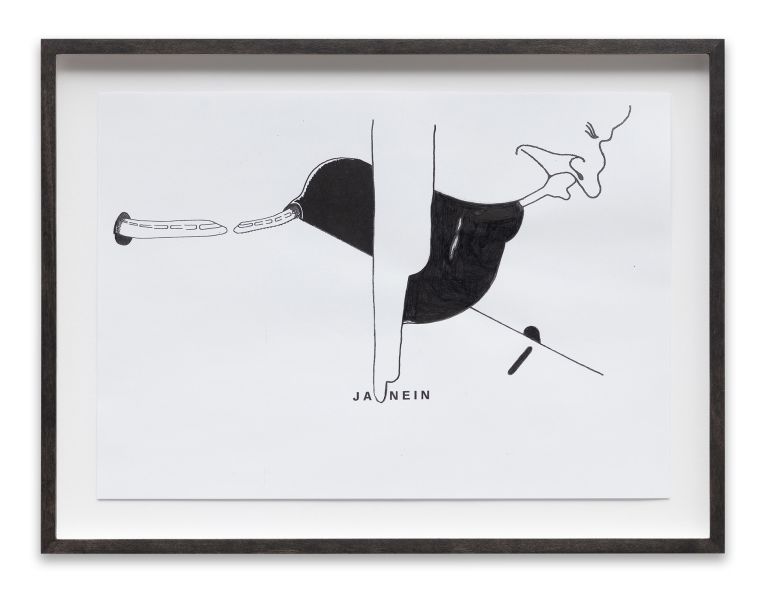
Mathew Hale / Eddie Ruscha
More Janine, 2020
Ink and laser-copy toner on paper
21 × 29.7 cm
8 1/4 × 11 3/4 inches

Mathew Hale / Eddie Ruscha
More Dog, 2020
Ink and laser-copy toner on paper
21 × 29.7 cm
8 1/4 × 11 3/4 inches

Mathew Hale / Eddie Ruscha
More Distance, 2020
Ink and laser-copy toner on paper
23 × 30 cm
9 × 11 7/8 inches

Mathew Hale / Eddie Ruscha
More Sheer, 2020
Ink, laser-copy toner, printed matter, on paper
21 × 29.7 cm
8 1/4 × 11 3/4 inches

Mathew Hale / Eddie Ruscha
More Dad, 2020
Ink and laser-copy toner on paper
21 × 29.7 cm
8 1/4 × 11 3/4 inches
Mathew Hale / Eddie Ruscha
More Dad, 2020
Ink and laser-copy toner on paper
21 × 29.7 cm
8 1/4 × 11 3/4 inches

Mathew Hale / Eddie Ruscha
More Thinking Cap, 2020
Ink and laser-copy toner on paper
21 × 29.7 cm
8 1/4 × 11 3/4 inches
Mathew Hale / Eddie Ruscha
More Thinking Cap, 2020
Ink and laser-copy toner on paper
21 × 29.7 cm
8 1/4 × 11 3/4 inches
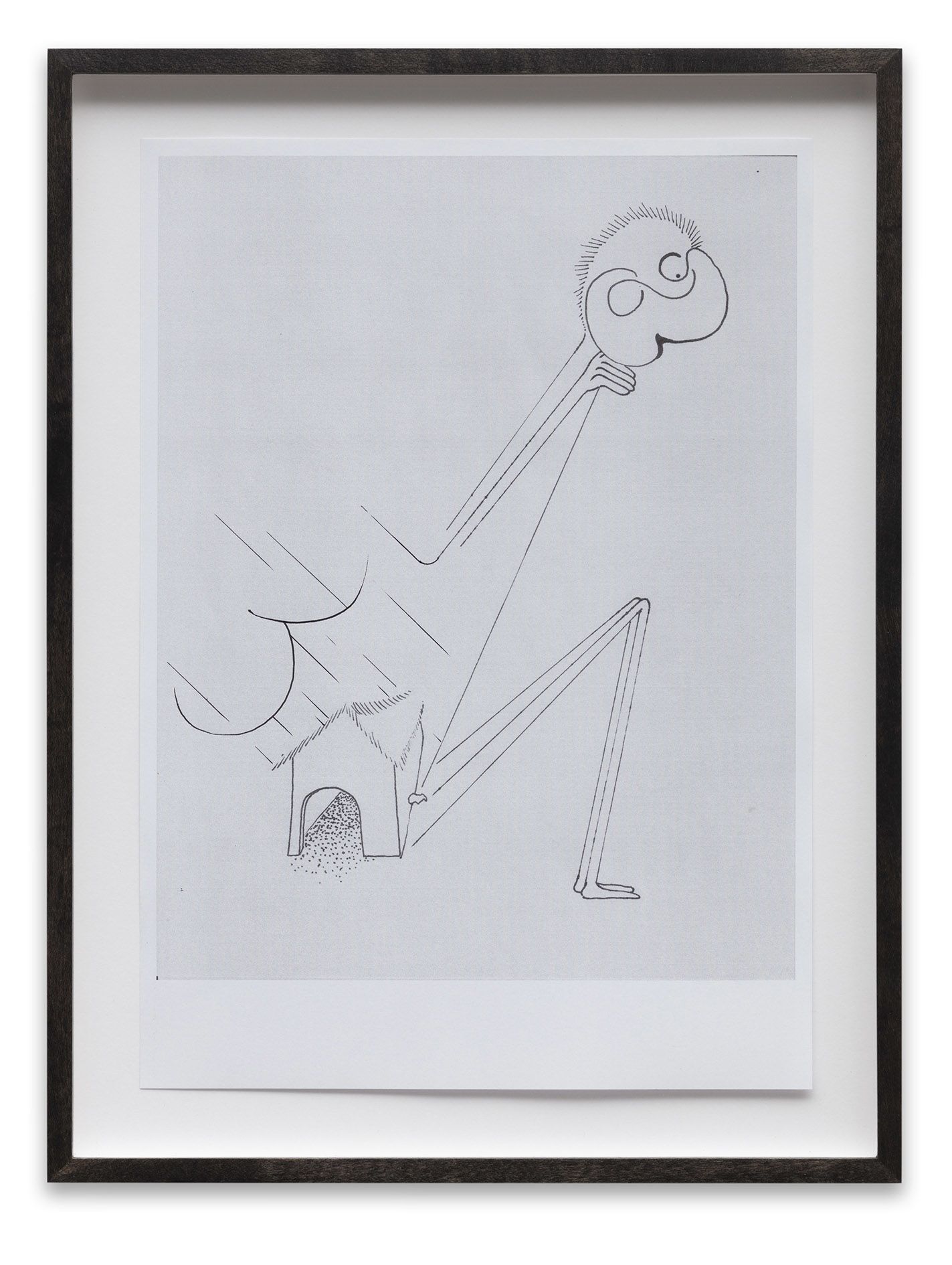
Mathew Hale / Eddie Ruscha
More Hutt, 2020
Ink and laser-copy toner on paper
21 × 29.7 cm
8 1/4 × 11 3/4 inches
Mathew Hale / Eddie Ruscha
More Hutt, 2020
Ink and laser-copy toner on paper
21 × 29.7 cm
8 1/4 × 11 3/4 inches

Mathew Hale / Eddie Ruscha
More Clapping, 2020
Ink and laser-copy toner on paper
21 × 29.7 cm
8 1/4 × 11 3/4 inches
Mathew Hale / Eddie Ruscha
More Clapping, 2020
Ink and laser-copy toner on paper
21 × 29.7 cm
8 1/4 × 11 3/4 inches

Mathew Hale / Eddie Ruscha
More Janine, 2020
Ink and laser-copy toner on paper
21 × 29.7 cm
8 1/4 × 11 3/4 inches
Mathew Hale / Eddie Ruscha
More Janine, 2020
Ink and laser-copy toner on paper
21 × 29.7 cm
8 1/4 × 11 3/4 inches

Mathew Hale / Eddie Ruscha
More Dog, 2020
Ink and laser-copy toner on paper
21 × 29.7 cm
8 1/4 × 11 3/4 inches
Mathew Hale / Eddie Ruscha
More Dog, 2020
Ink and laser-copy toner on paper
21 × 29.7 cm
8 1/4 × 11 3/4 inches

Mathew Hale / Eddie Ruscha
More Distance, 2020
Ink and laser-copy toner on paper
23 × 30 cm
9 × 11 7/8 inches
Mathew Hale / Eddie Ruscha
More Distance, 2020
Ink and laser-copy toner on paper
23 × 30 cm
9 × 11 7/8 inches

Mathew Hale / Eddie Ruscha
More Sheer, 2020
Ink, laser-copy toner, printed matter, on paper
21 × 29.7 cm
8 1/4 × 11 3/4 inches
Mathew Hale / Eddie Ruscha
More Sheer, 2020
Ink, laser-copy toner, printed matter, on paper
21 × 29.7 cm
8 1/4 × 11 3/4 inches
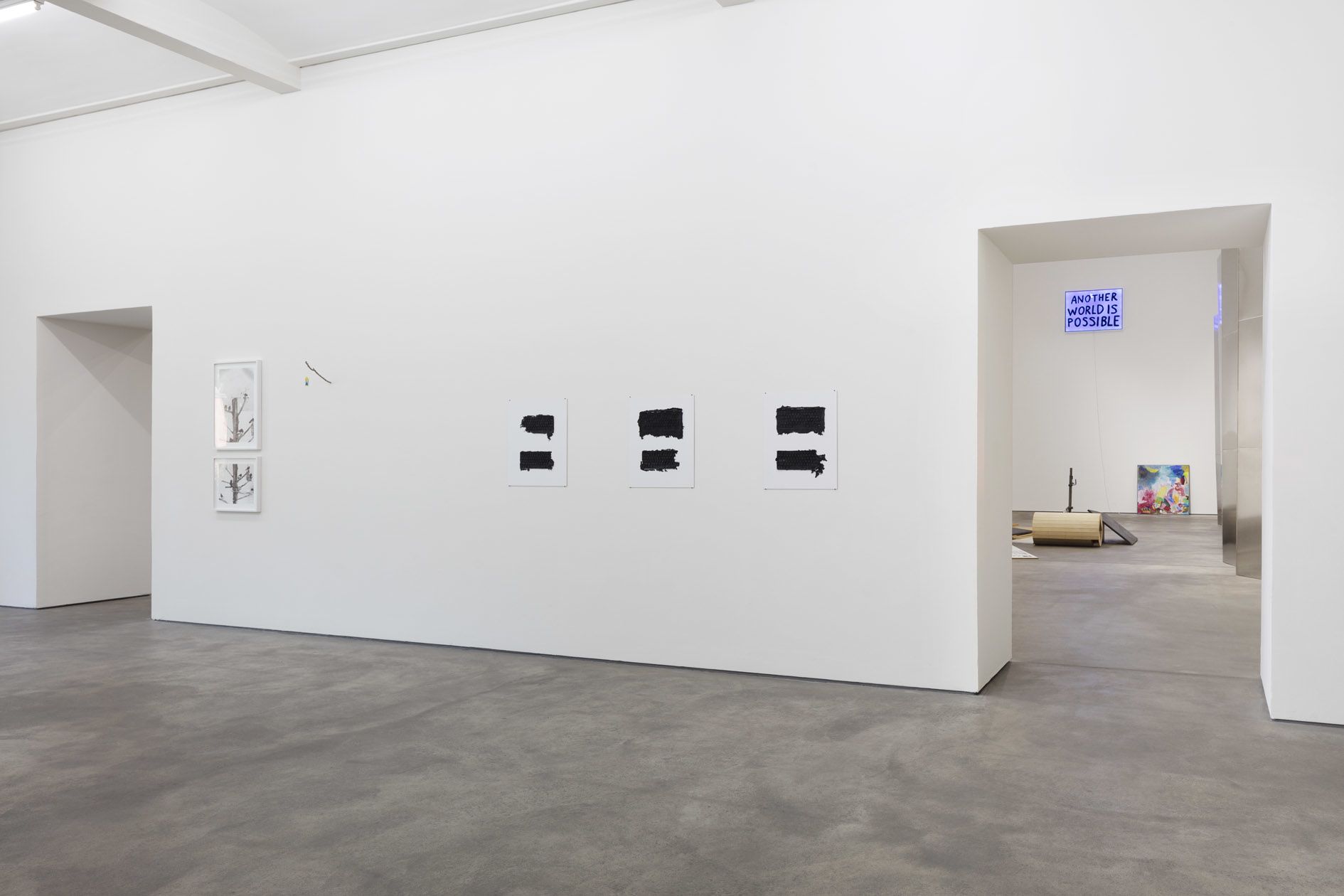
During our period of isolation, the computer has been an important means of communicating with colleagues, friends and family. Cast in silicon by Henrik Olesen, these three keyboards, titled Auflösung I, II & III (Dissolution I, II & II) (2020), convey a tactility that evokes the fragility of the human body, further emphasized by the frayed edges that seem to be in a state of decay.

Henrik Olesen
Auflösung I, 2020
Silicone on board
60 × 50 cm
23 5/8 × 19 3/4 inches

Henrik Olesen
Auflösung I, 2020 (detail)

Henrik Olesen
Auflösung II, 2020
Silicone on board
60 × 50 cm
23 5/8 × 19 3/4 inches

Henrik Olesen
Auflösung II, 2020 (detail)

Henrik Olesen
Auflösung III, 2020
Silicone on board
60 × 50 cm
23 5/8 × 19 3/4 inches

Henrik Olesen
Auflösung III, 2020 (detail)

Henrik Olesen
Auflösung I, 2020
Silicone on board
60 × 50 cm
23 5/8 × 19 3/4 inches
Henrik Olesen
Auflösung I, 2020
Silicone on board
60 × 50 cm
23 5/8 × 19 3/4 inches
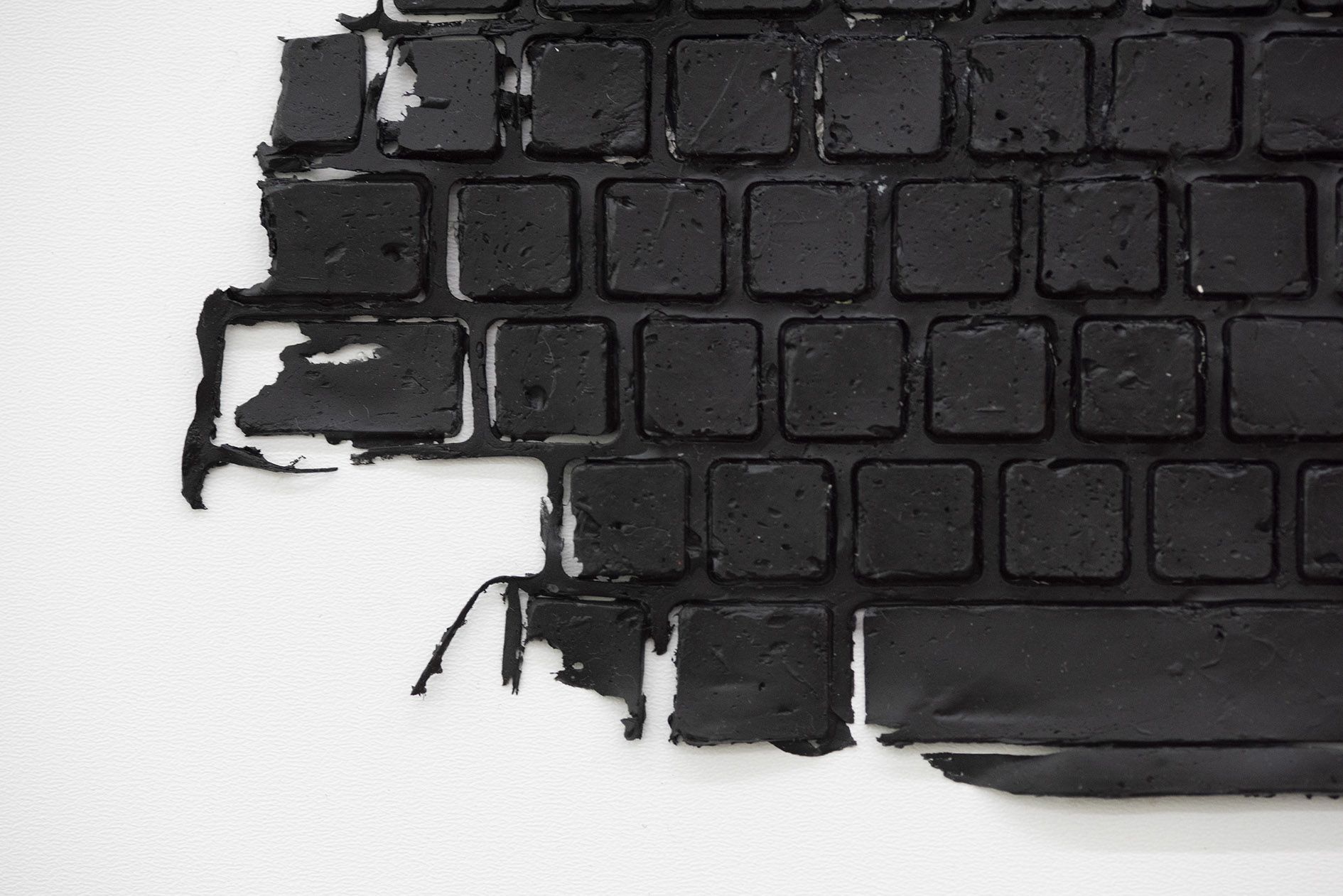

Henrik Olesen
Auflösung I, 2020 (detail)

Henrik Olesen
Auflösung II, 2020
Silicone on board
60 × 50 cm
23 5/8 × 19 3/4 inches
Henrik Olesen
Auflösung II, 2020
Silicone on board
60 × 50 cm
23 5/8 × 19 3/4 inches


Henrik Olesen
Auflösung II, 2020 (detail)

Henrik Olesen
Auflösung III, 2020
Silicone on board
60 × 50 cm
23 5/8 × 19 3/4 inches
Henrik Olesen
Auflösung III, 2020
Silicone on board
60 × 50 cm
23 5/8 × 19 3/4 inches


Henrik Olesen
Auflösung III, 2020 (detail)
During our period of isolation, the computer has been an important means of communicating with colleagues, friends and family. Cast in silicon by Henrik Olesen, these three keyboards, titled Auflösung I, II & III (Dissolution I, II & II) (2020), convey a tactility that evokes the fragility of the human body, further emphasized by the frayed edges that seem to be in a state of decay.
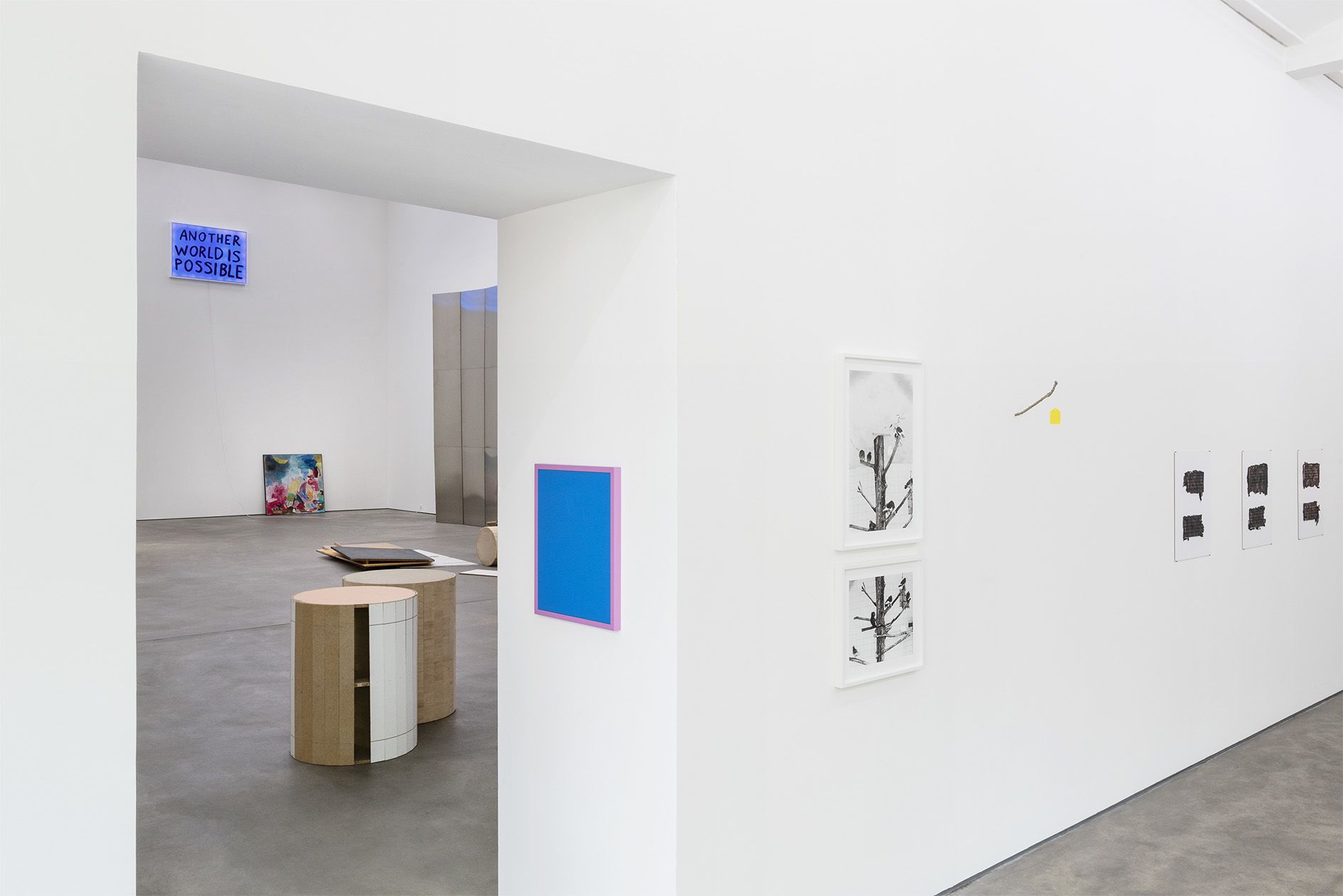
The faint abstract engravings of Gerwald Rockenshaub’s works (2020) may refer to studies of nature, while also asserting themselves autonomously as prototypes for unrealized work. Depicting what might be a mountain or a wave, their monochrome surfaces glow from the brightness of their pink frame and support, conveying at once a sense of promise and emptiness.

Gerwald Rockenschaub
Acrylic glass in MDF frame, varnished, 2020
54 × 44 × 3 cm
21 1/4 × 17 1/4 × 1 1/8 inches

Gerwald Rockenschaub
Acrylic glass in MDF frame, varnished, 2020
54 × 44 × 3 cm
21 1/4 × 17 1/4 × 1 1/8 inches

Gerwald Rockenschaub
Acrylic glass in MDF frame, varnished, 2020 (detail)

Gerwald Rockenschaub
Acrylic glass in MDF frame, varnished, 2020
54 × 44 × 3 cm
21 1/4 × 17 1/4 × 1 1/8 inches
Gerwald Rockenschaub
Acrylic glass in MDF frame, varnished, 2020
54 × 44 × 3 cm
21 1/4 × 17 1/4 × 1 1/8 inches


Gerwald Rockenschaub
Acrylic glass in MDF frame, varnished, 2020
54 × 44 × 3 cm
21 1/4 × 17 1/4 × 1 1/8 inches


Gerwald Rockenschaub
Acrylic glass in MDF frame, varnished, 2020 (detail)

Gerwald Rockenschaub
Acrylic glass, mounted on MDF, varnished, 2020
50 × 40 × 3.5 cm
19 3/4 × 15 3/4 × 1 3/8 inches

Gerwald Rockenschaub
Acrylic glass, mounted on MDF, varnished, 2020
50 × 40 × 3.5 cm
19 3/4 × 15 3/4 × 1 3/8 inches

Gerwald Rockenschaub
Acrylic glass, mounted on MDF, varnished, 2020 (detail)

Gerwald Rockenschaub
Acrylic glass, mounted on MDF, varnished, 2020
50 × 40 × 3.5 cm
19 3/4 × 15 3/4 × 1 3/8 inches
Gerwald Rockenschaub
Acrylic glass, mounted on MDF, varnished, 2020
50 × 40 × 3.5 cm
19 3/4 × 15 3/4 × 1 3/8 inches


Gerwald Rockenschaub
Acrylic glass, mounted on MDF, varnished, 2020
50 × 40 × 3.5 cm
19 3/4 × 15 3/4 × 1 3/8 inches
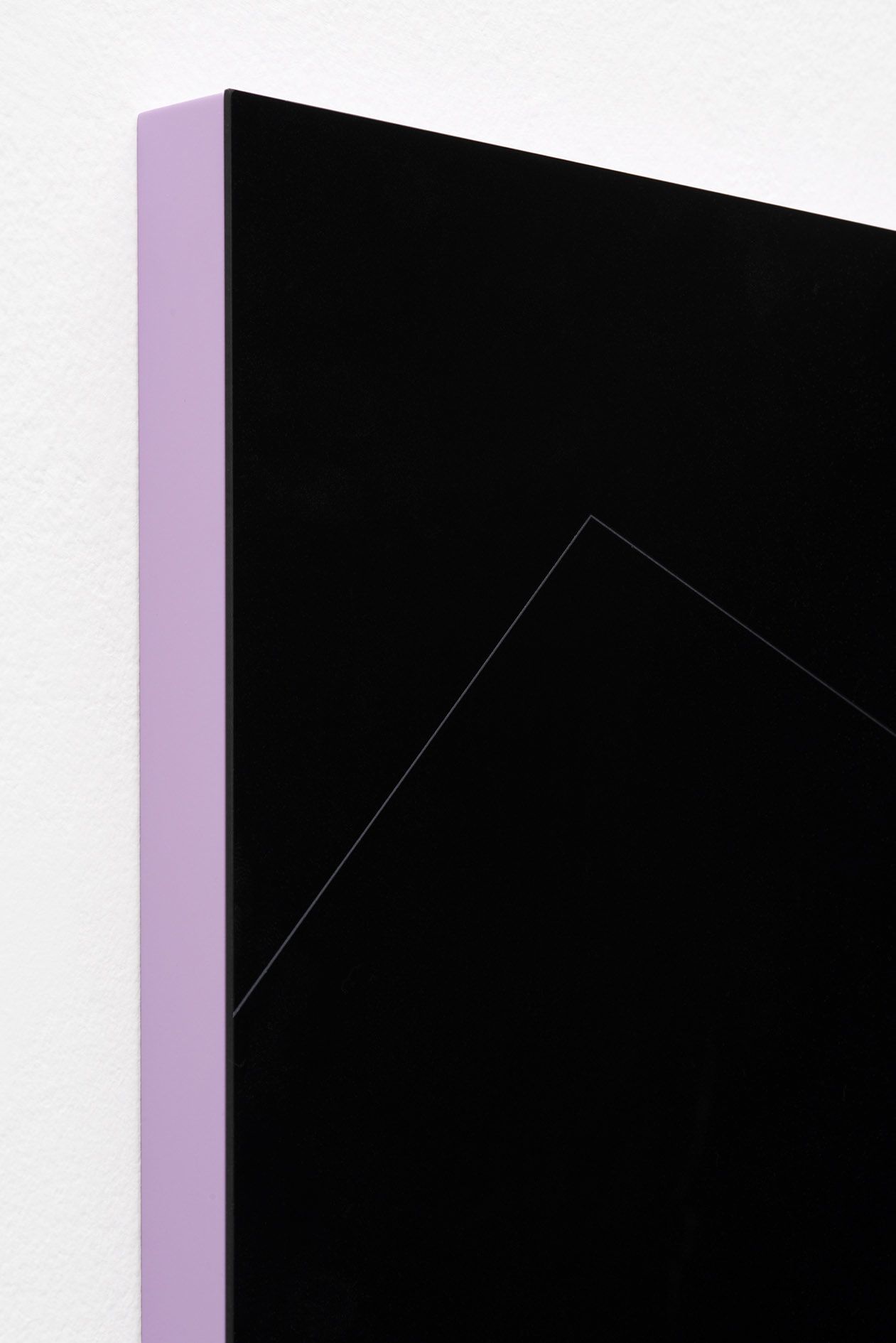

Gerwald Rockenschaub
Acrylic glass, mounted on MDF, varnished, 2020 (detail)
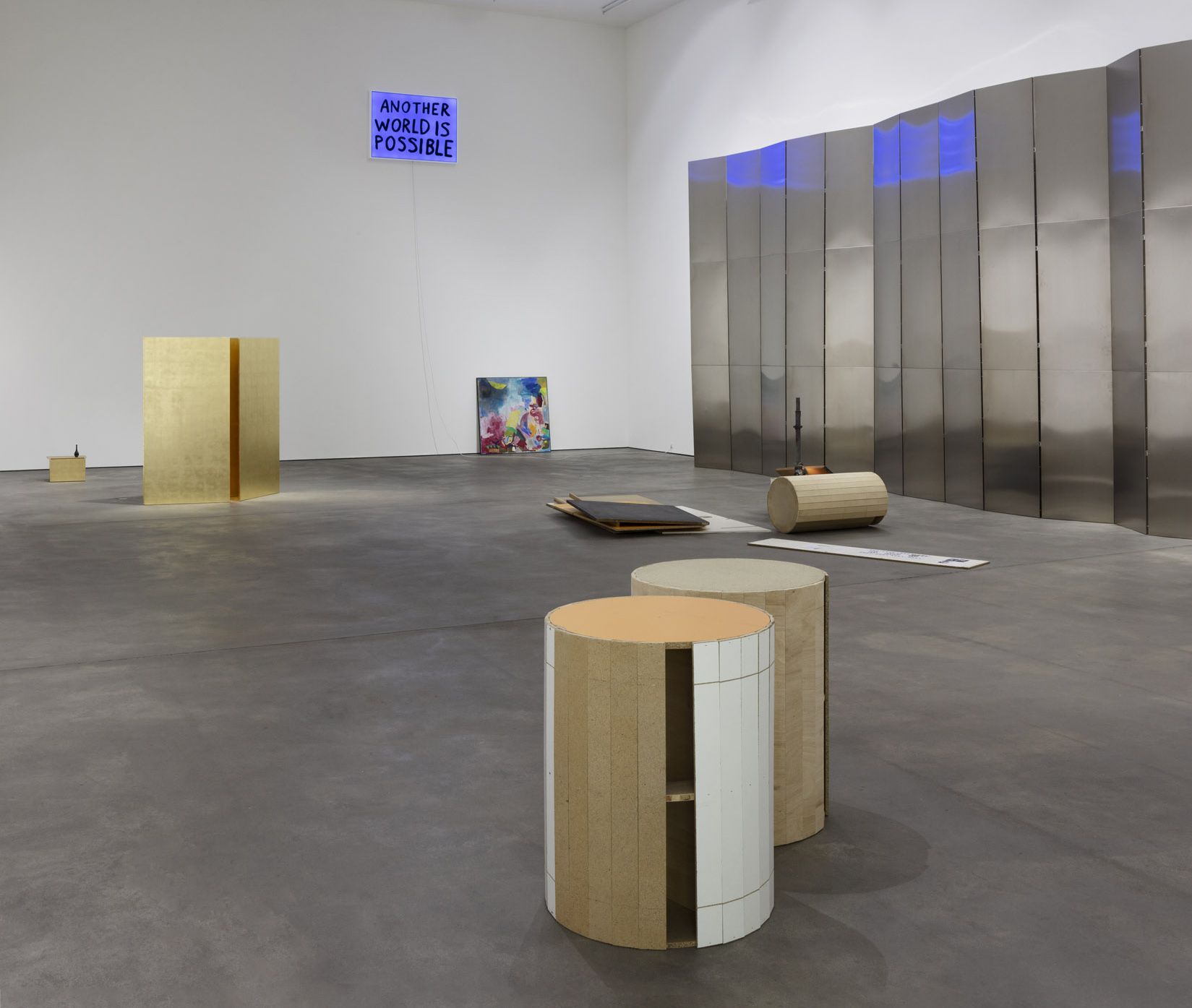
The reflective aluminum sidings of Thea Djordjadze’s Why Hold on to That? (2020) recall both domestic furniture such as room dividers and a wider vocabulary of industrial architecture. Stretching to nearly five meters high, they function as a near-mirrored surface that engages with the rest of the exhibition. The reflects the moment of reconsideration regarding our habitual inventory which has been a common reaction to the solitude of the crisis: Why Hold on to That?
Furthermore, for some ‘lockdown’ has meant more time with family, which might impinge upon our work, Thea Djordjadze has suggested the opposite with an untitled painting on plaster (2020) created in collaboration with her young daughter. Recalling the exuberance of early twentieth-century modernist experiments in painting, there is a childish, unhinged element to the daubs of color.

Thea Djordjadze
Untitled, 2020
Wood, plaster, paint
130 × 130 × 4 cm
51 1/8 × 51 1/8 × 1 5/8 inches

Thea Djordjadze
Untitled, 2020 (detail)

Thea Djordjadze
Untitled, 2020 (detail)

Thea Djordjadze
Untitled, 2020 (detail)

Thea Djordjadze
Untitled, 2020 (detail)

Thea Djordjadze
Untitled, 2020 (detail)

Thea Djordjadze
Untitled, 2020
Wood, plaster, paint
130 × 130 × 4 cm
51 1/8 × 51 1/8 × 1 5/8 inches
Thea Djordjadze
Untitled, 2020
Wood, plaster, paint
130 × 130 × 4 cm
51 1/8 × 51 1/8 × 1 5/8 inches


Thea Djordjadze
Untitled, 2020 (detail)


Thea Djordjadze
Untitled, 2020 (detail)


Thea Djordjadze
Untitled, 2020 (detail)
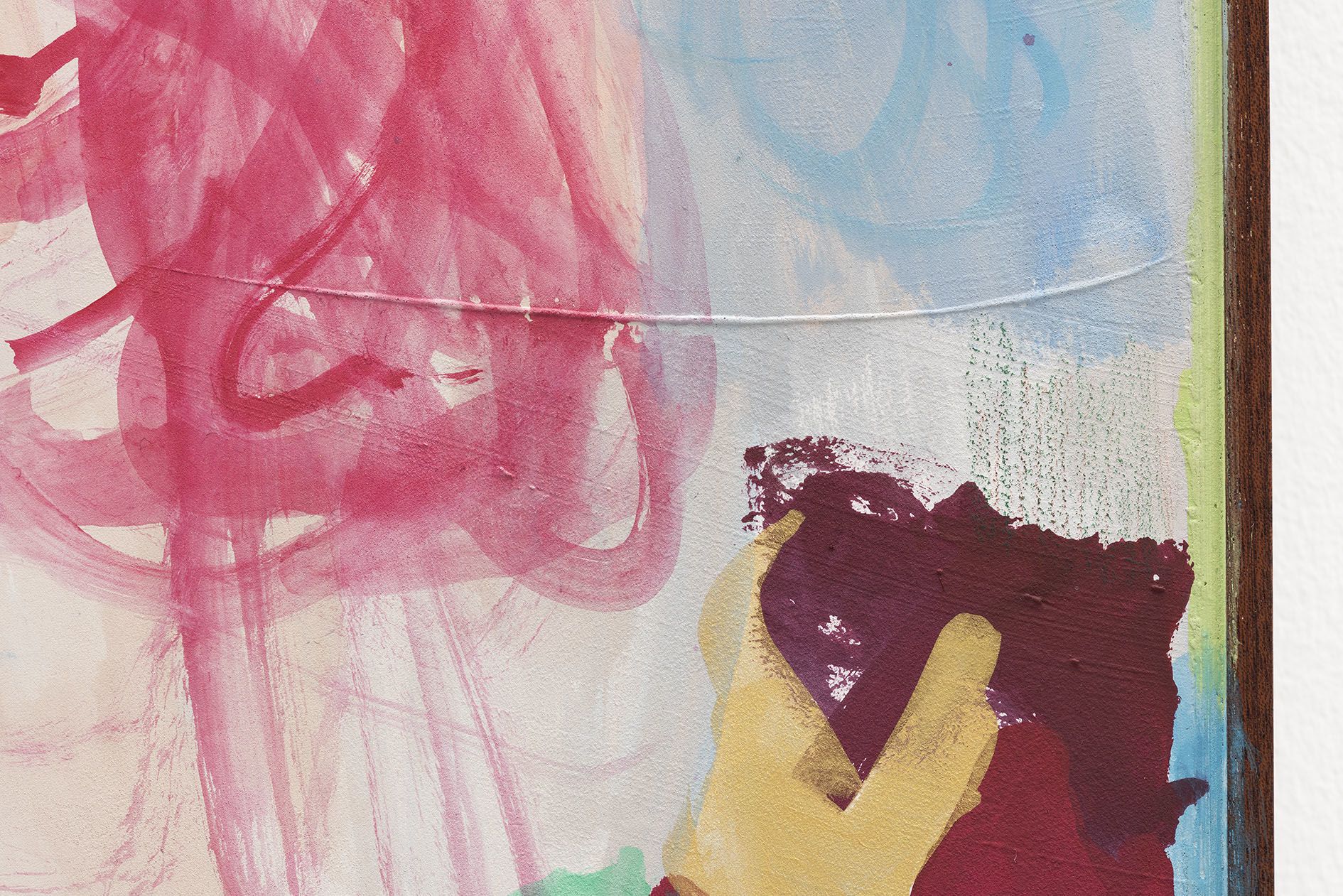

Thea Djordjadze
Untitled, 2020 (detail)


Thea Djordjadze
Untitled, 2020 (detail)
Furthermore, for some ‘lockdown’ has meant more time with family, which might impinge upon our work, Thea Djordjadze has suggested the opposite with an untitled painting on plaster (2020) created in collaboration with her young daughter. Recalling the exuberance of early twentieth-century modernist experiments in painting, there is a childish, unhinged element to the daubs of color.

Sam Durant
Another World is Possible, 2019
Electric sign with vinyl text
111.8 × 152.4 cm
44 × 60 inches
Edition of 3 + 2 AP

Sam Durant
Another World is Possible, 2019
Electric sign with vinyl text
111.8 × 152.4 cm
44 × 60 inches
Edition of 3 + 2 AP
Another World is Possible (2020), reproduced from a real protest sign by Sam Durant, becomes especially pertinent amidst the pandemic and protests across the world, questioning and eroding the status quo. Both the text and font are copied precisely from their original source, replicated as a light box not dissimilar to those used for advertising. However, the slogan still evokes our longing for a change and hope for a better future.

Sam Durant
Another World is Possible, 2019
Electric sign with vinyl text
111.8 × 152.4 cm
44 × 60 inches
Edition of 3 + 2 AP
Sam Durant
Another World is Possible, 2019
Electric sign with vinyl text
111.8 × 152.4 cm
44 × 60 inches
Edition of 3 + 2 AP


Sam Durant
Another World is Possible, 2019
Electric sign with vinyl text
111.8 × 152.4 cm
44 × 60 inches
Edition of 3 + 2 AP
Another World is Possible (2020), reproduced from a real protest sign by Sam Durant, becomes especially pertinent amidst the pandemic and protests across the world, questioning and eroding the status quo. Both the text and font are copied precisely from their original source, replicated as a light box not dissimilar to those used for advertising. However, the slogan still evokes our longing for a change and hope for a better future.
Spread across three locations in the exhibition, Manfred Pernice’s Strandgut III (Flotsam III) (1999–2020) makes use of seemingly discarded pieces of material—old cupboard doors and pieces of board, scraps of metal, a still-functioning lightbulb—to interrogate and repurpose the individual histories of each fragment. More meticulously crafted barrel-like structures resemble furniture or containers for something unspecified, alluding further to an unpredictable future. Pernice’s proposition to the current situation is to re-evaluate the existing inventory as sufficient and settle with the existing in changing constellations: the sculpture has been shown twice before, but in fundamentally different configurations.

Manfred Pernice
Strandgut III, 2019
Wood, paint, electrics, metal
105 cm × 208 cm × 245 cm (variable)

Manfred Pernice
Strandgut III, 2019
Wood, paint, electrics, metal
105 cm × 208 cm × 245 cm (variable)

Manfred Pernice
Strandgut III, 2019
Wood, paint, electrics, metal
105 cm × 208 cm × 245 cm (variable)

Manfred Pernice
Strandgut III, 2019
Wood, paint, electrics, metal
105 cm × 208 cm × 245 cm (variable)
Manfred Pernice
Strandgut III, 2019
Wood, paint, electrics, metal
105 cm × 208 cm × 245 cm (variable)


Manfred Pernice
Strandgut III, 2019
Wood, paint, electrics, metal
105 cm × 208 cm × 245 cm (variable)


Manfred Pernice
Strandgut III, 2019
Wood, paint, electrics, metal
105 cm × 208 cm × 245 cm (variable)
Spread across three locations in the exhibition, Manfred Pernice’s Strandgut III (Flotsam III) (1999–2020) makes use of seemingly discarded pieces of material—old cupboard doors and pieces of board, scraps of metal, a still-functioning lightbulb—to interrogate and repurpose the individual histories of each fragment. More meticulously crafted barrel-like structures resemble furniture or containers for something unspecified, alluding further to an unpredictable future. Pernice’s proposition to the current situation is to re-evaluate the existing inventory as sufficient and settle with the existing in changing constellations: the sculpture has been shown twice before, but in fundamentally different configurations.
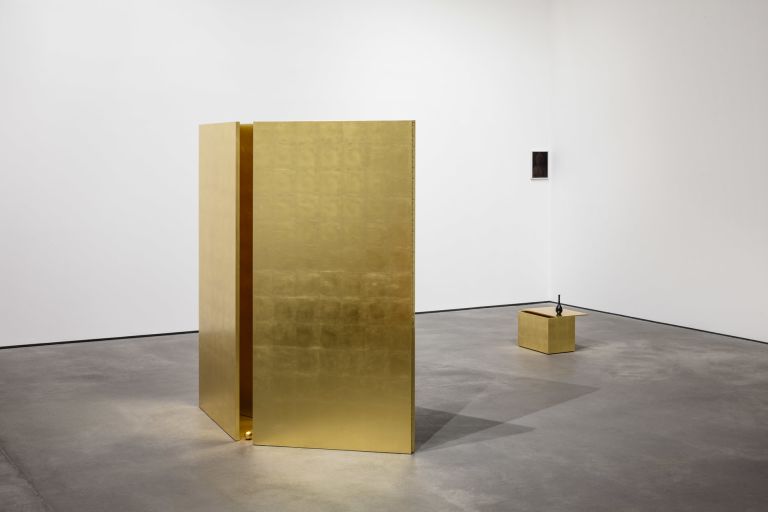
Haris Epaminonda
Untitled #01 a/j, 2020
Brass gilding on wooden panels and two spheres with gilding on wood
Overall Dimensions: 192 × 181 × 48,3 cm
Two spheres: 5 × 5 × 5 cm and 12 × 12 × 12 cm
Overall Dimensions: 75 5/8 × 71 1/4 × 19 inches
Two spheres: 2 × 2 × 2 inches and 4 3/4 × 4 3/4 × 4 3/4 inches
Edition unique

Haris Epaminonda
Untitled #01 a/j, 2020
Brass gilding on wooden panels and two spheres with gilding on wood
Overall Dimensions: 192 × 181 × 48,3 cm
Two spheres: 5 × 5 × 5 cm and 12 × 12 × 12 cm
Overall Dimensions: 75 5/8 × 71 1/4 × 19 inches
Two spheres: 2 × 2 × 2 inches and 4 3/4 × 4 3/4 × 4 3/4 inches
Edition unique

Haris Epaminonda
Untitled #01 a/j, 2020 (detail)

Haris Epaminonda
Untitled #01 a/j, 2020
Brass gilding on wooden panels and two spheres with gilding on wood
Overall Dimensions: 192 × 181 × 48,3 cm
Two spheres: 5 × 5 × 5 cm and 12 × 12 × 12 cm
Overall Dimensions: 75 5/8 × 71 1/4 × 19 inches
Two spheres: 2 × 2 × 2 inches and 4 3/4 × 4 3/4 × 4 3/4 inches
Edition unique

Haris Epaminonda
Untitled #01 a/j, 2020
Brass gilding on wooden panels and two spheres with gilding on wood
Overall Dimensions: 192 × 181 × 48,3 cm
Two spheres: 5 × 5 × 5 cm and 12 × 12 × 12 cm
Overall Dimensions: 75 5/8 × 71 1/4 × 19 inches
Two spheres: 2 × 2 × 2 inches and 4 3/4 × 4 3/4 × 4 3/4 inches
Edition unique
Haris Epaminonda
Untitled #01 a/j, 2020
Brass gilding on wooden panels and two spheres with gilding on wood
Overall Dimensions: 192 × 181 × 48,3 cm
Two spheres: 5 × 5 × 5 cm and 12 × 12 × 12 cm
Overall Dimensions: 75 5/8 × 71 1/4 × 19 inches
Two spheres: 2 × 2 × 2 inches and 4 3/4 × 4 3/4 × 4 3/4 inches
Edition unique


Haris Epaminonda
Untitled #01 a/j, 2020
Brass gilding on wooden panels and two spheres with gilding on wood
Overall Dimensions: 192 × 181 × 48,3 cm
Two spheres: 5 × 5 × 5 cm and 12 × 12 × 12 cm
Overall Dimensions: 75 5/8 × 71 1/4 × 19 inches
Two spheres: 2 × 2 × 2 inches and 4 3/4 × 4 3/4 × 4 3/4 inches
Edition unique
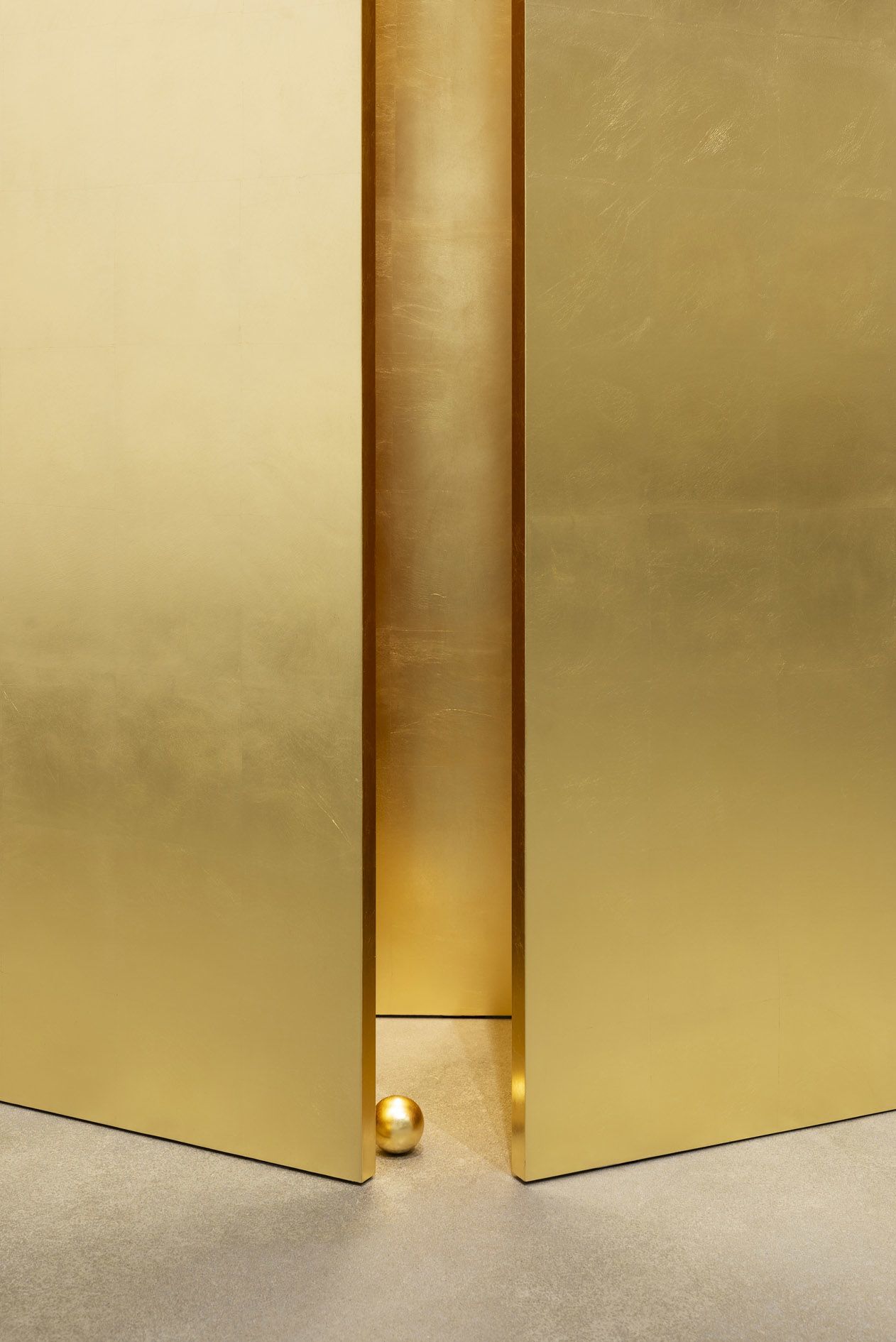

Haris Epaminonda
Untitled #01 a/j, 2020 (detail)


Haris Epaminonda
Untitled #01 a/j, 2020
Brass gilding on wooden panels and two spheres with gilding on wood
Overall Dimensions: 192 × 181 × 48,3 cm
Two spheres: 5 × 5 × 5 cm and 12 × 12 × 12 cm
Overall Dimensions: 75 5/8 × 71 1/4 × 19 inches
Two spheres: 2 × 2 × 2 inches and 4 3/4 × 4 3/4 × 4 3/4 inches
Edition unique

Haris Epaminonda
Untitled #02 a/j, 2020
Box with brass gilding on wood, lid with brass gilding on wood and black ink on chalk base, black patinated old bronze vase, brass cricket and framed found book page
Box: 30 × 45 × 28 cm
Lid/ Vase: 16.5 × 6 × 6 cm
Cricket: 14 × 5 × 5 cm
Framed book page: 30.9 × 23.7 × 2.5 cm
Box: 11 7/8 × 17 3/4 × 11 inches
Lid/ Vase: 6 1/2 × 2 3/8 × 2 3/8 inches
Cricket: 1/2 × 2 × 2 inches
Framed book page: 12 1/8 × 9 1/4 × 1 inches
Edition unique

Haris Epaminonda
Untitled #02 a/j, 2020
Box with brass gilding on wood, lid with brass gilding on wood and black ink on chalk base, black patinated old bronze vase, brass cricket and framed found book page
Holzkasten: 30 × 45 × 28 cm
Holzdeckel/ Vase: 16.5 × 6 × 6 cm
Grille: 14 × 5 × 5 cm
Gerahmte Buchseite: 30.9 × 23.7 × 2.5 cm
Box: 11 7/8 × 17 3/4 × 11 inches
Lid/ Vase:6 1/2 × 2 3/8 × 2 3/8 inches
Cricket: 1/2 × 2 × 2 inches
Framed book page: 12 1/8 × 9 1/4 × 1 inches
Edition unique

Haris Epaminonda
Untitled #02 a/j, 2020
Box with brass gilding on wood, lid with brass gilding on wood and black ink on chalk base, black patinated old bronze vase, brass cricket and framed found book page
Holzkasten: 30 × 45 × 28 cm
Holzdeckel/ Vase: 16.5 × 6 × 6 cm
Grille: 14 × 5 × 5 cm
Gerahmte Buchseite: 30.9 × 23.7 × 2.5 cm
Box: 11 7/8 × 17 3/4 × 11 inches
Lid/ Vase:6 1/2 × 2 3/8 × 2 3/8 inches
Cricket: 1/2 × 2 × 2 inches
Framed book page: 12 1/8 × 9 1/4 × 1 inches
Edition unique
Starting with funerary customs in ancient Egypt, Haris Epaminonda’s gilded brass objects and assemblages Untitled #01 a/j and Untitled #02 a/j (both 2020) make reference to an entry to a burial chamber and a reliquary or sarcophagus respectively. Reminding the viewer of the fragility of their own existence, small objects such as a locust and an adjacent portrait refer further to the ancient civilization, offering a literal and metaphorical portal into the afterlife. In that context, she emphasizes the absolute dimension of the crisis, the mortal thread it inevitably poses.

Haris Epaminonda
Untitled #02 a/j, 2020
Box with brass gilding on wood, lid with brass gilding on wood and black ink on chalk base, black patinated old bronze vase, brass cricket and framed found book page
Box: 30 × 45 × 28 cm
Lid/ Vase: 16.5 × 6 × 6 cm
Cricket: 14 × 5 × 5 cm
Framed book page: 30.9 × 23.7 × 2.5 cm
Box: 11 7/8 × 17 3/4 × 11 inches
Lid/ Vase: 6 1/2 × 2 3/8 × 2 3/8 inches
Cricket: 1/2 × 2 × 2 inches
Framed book page: 12 1/8 × 9 1/4 × 1 inches
Edition unique
Haris Epaminonda
Untitled #02 a/j, 2020
Box with brass gilding on wood, lid with brass gilding on wood and black ink on chalk base, black patinated old bronze vase, brass cricket and framed found book page
Box: 30 × 45 × 28 cm
Lid/ Vase: 16.5 × 6 × 6 cm
Cricket: 14 × 5 × 5 cm
Framed book page: 30.9 × 23.7 × 2.5 cm
Box: 11 7/8 × 17 3/4 × 11 inches
Lid/ Vase: 6 1/2 × 2 3/8 × 2 3/8 inches
Cricket: 1/2 × 2 × 2 inches
Framed book page: 12 1/8 × 9 1/4 × 1 inches
Edition unique


Haris Epaminonda
Untitled #02 a/j, 2020
Box with brass gilding on wood, lid with brass gilding on wood and black ink on chalk base, black patinated old bronze vase, brass cricket and framed found book page
Holzkasten: 30 × 45 × 28 cm
Holzdeckel/ Vase: 16.5 × 6 × 6 cm
Grille: 14 × 5 × 5 cm
Gerahmte Buchseite: 30.9 × 23.7 × 2.5 cm
Box: 11 7/8 × 17 3/4 × 11 inches
Lid/ Vase:6 1/2 × 2 3/8 × 2 3/8 inches
Cricket: 1/2 × 2 × 2 inches
Framed book page: 12 1/8 × 9 1/4 × 1 inches
Edition unique


Haris Epaminonda
Untitled #02 a/j, 2020
Box with brass gilding on wood, lid with brass gilding on wood and black ink on chalk base, black patinated old bronze vase, brass cricket and framed found book page
Holzkasten: 30 × 45 × 28 cm
Holzdeckel/ Vase: 16.5 × 6 × 6 cm
Grille: 14 × 5 × 5 cm
Gerahmte Buchseite: 30.9 × 23.7 × 2.5 cm
Box: 11 7/8 × 17 3/4 × 11 inches
Lid/ Vase:6 1/2 × 2 3/8 × 2 3/8 inches
Cricket: 1/2 × 2 × 2 inches
Framed book page: 12 1/8 × 9 1/4 × 1 inches
Edition unique
Starting with funerary customs in ancient Egypt, Haris Epaminonda’s gilded brass objects and assemblages Untitled #01 a/j and Untitled #02 a/j (both 2020) make reference to an entry to a burial chamber and a reliquary or sarcophagus respectively. Reminding the viewer of the fragility of their own existence, small objects such as a locust and an adjacent portrait refer further to the ancient civilization, offering a literal and metaphorical portal into the afterlife. In that context, she emphasizes the absolute dimension of the crisis, the mortal thread it inevitably poses.
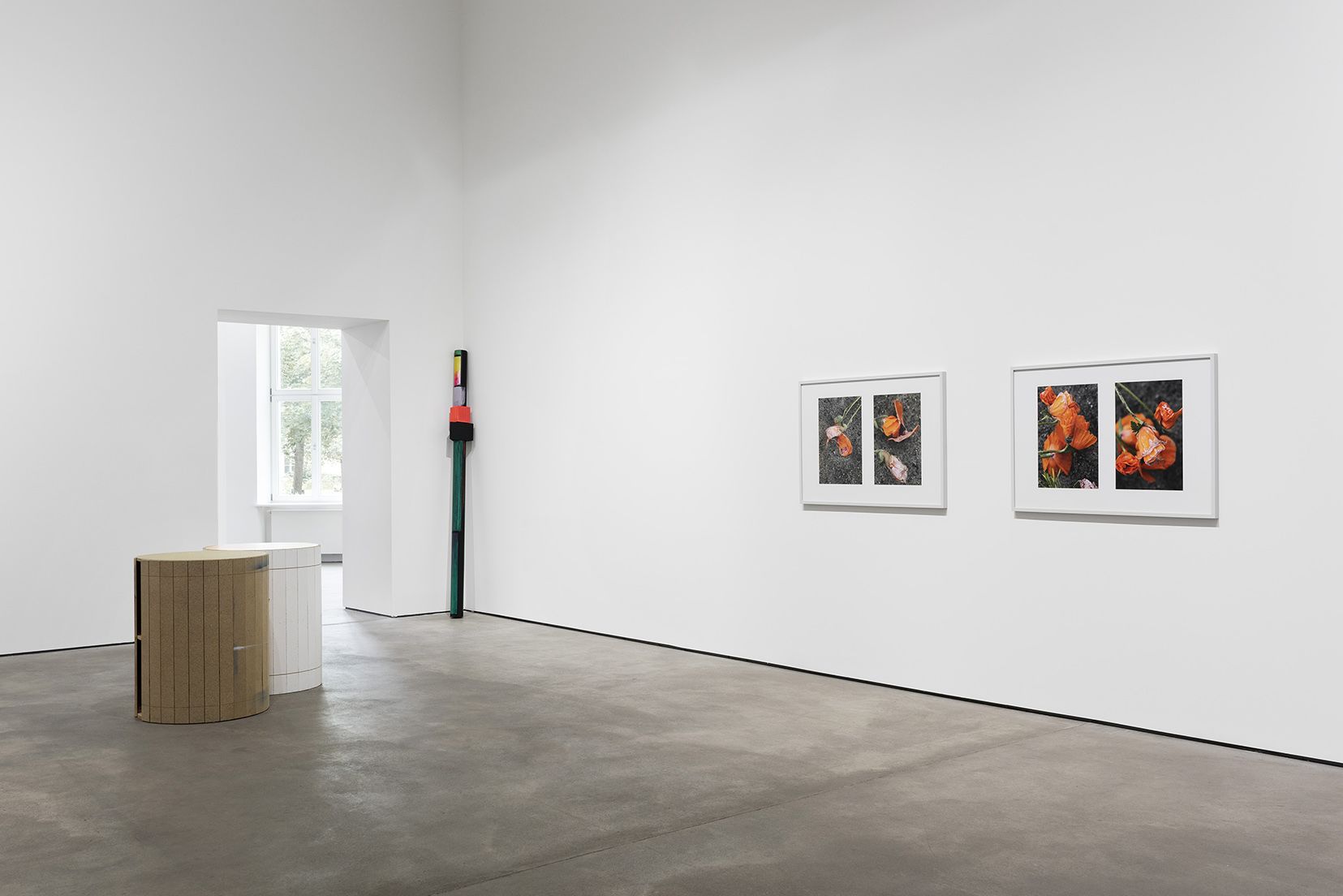
In these photographs of slightly flattened, dead and decaying poppies, Thomas Struth muses on the history of vanitas painting. Titled Orientalischer Mohn (Papaver Orientale), Feldberger Seenlandschaft 1 and 2 (2020), the flowers here are an invasive species. In their forlorn state, the poppies might lose some of their typical references to war or opiates, yet still convey a shock of red against the dark ground. With these images, Struth is insisting on practising even if the artist is bereft of his modes of working.

Thomas Struth
Orientalischer Mohn (Papaver orientale) 1, Feldberger Seenlandschaft 2020, 2020
inkjet print
77.5 × 115 cm
30 1/2 × 45 1/4 inches
81.5 × 119 cm (framed)
32 × 46 7/8 inches (framed)
Edition of 10

Thomas Struth
Orientalischer Mohn (Papaver orientale) 1, Feldberger Seenlandschaft 2020, 2020
inkjet print
77.5 × 115 cm
30 1/2 × 45 1/4 inches
81.5 × 119 cm (framed)
32 × 46 7/8 inches (framed)
Edition of 10
Thomas Struth
Orientalischer Mohn (Papaver orientale) 1, Feldberger Seenlandschaft 2020, 2020
inkjet print
77.5 × 115 cm
30 1/2 × 45 1/4 inches
81.5 × 119 cm (framed)
32 × 46 7/8 inches (framed)
Edition of 10

Thomas Struth
Orientalischer Mohn (Papaver orientale) 2, Feldberger Seenlandschaft 2020, 2020
inkjet print
77.5 × 115 cm
30 1/2 × 45 1/4 inches
81.5 × 119 cm (framed)
32 × 46 7/8 inches (framed)
Edition of 10

Thomas Struth
Orientalischer Mohn (Papaver orientale) 2, Feldberger Seenlandschaft 2020, 2020
inkjet print
77.5 × 115 cm
30 1/2 × 45 1/4 inches
81.5 × 119 cm (framed)
32 × 46 7/8 inches (framed)
Edition of 10
Thomas Struth
Orientalischer Mohn (Papaver orientale) 2, Feldberger Seenlandschaft 2020, 2020
inkjet print
77.5 × 115 cm
30 1/2 × 45 1/4 inches
81.5 × 119 cm (framed)
32 × 46 7/8 inches (framed)
Edition of 10

Thomas Scheibitz
Kapital VI, 2019
MDF, cardboard mounted, vinyl and acrylic
247 × 11.5 cm
98 3/8 × 4 3/4 inches
A strange and brightly colored baton leaning in the corner of the room, Thomas Scheibitz’s Kapital VI (2019) is an unlikely assemblage of different materials and textures. In slightly oversized scale it could resemble a piece of street furniture, seemingly redundant, or it could be a ceremonial weapon. The Marxian reference in the title brings to mind the hardships predicted by economists as a consequence of the pandemic, like a thread from the inevitable future.

Thomas Scheibitz
Kapital VI, 2019
MDF, cardboard mounted, vinyl and acrylic
247 × 11.5 cm
98 3/8 × 4 3/4 inches
Thomas Scheibitz
Kapital VI, 2019
MDF, cardboard mounted, vinyl and acrylic
247 × 11.5 cm
98 3/8 × 4 3/4 inches
A strange and brightly colored baton leaning in the corner of the room, Thomas Scheibitz’s Kapital VI (2019) is an unlikely assemblage of different materials and textures. In slightly oversized scale it could resemble a piece of street furniture, seemingly redundant, or it could be a ceremonial weapon. The Marxian reference in the title brings to mind the hardships predicted by economists as a consequence of the pandemic, like a thread from the inevitable future.
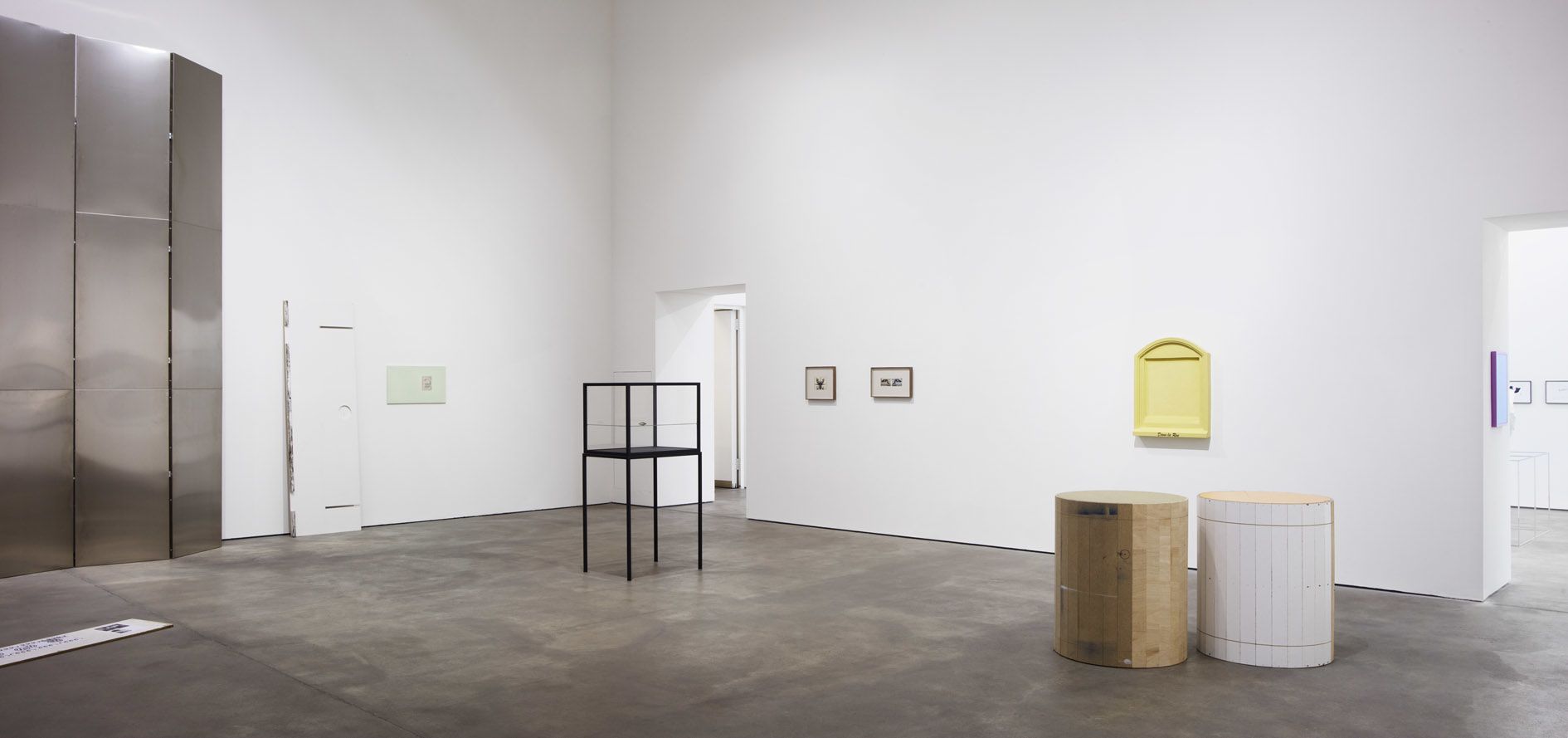

Marieta Chirulescu
untitled, 2020
Acrylic, UV-print on canvas
42 × 73 cm
16 1/2 × 28 3/4 inches

Marieta Chirulescu
untitled, 2020
Inkjet print, gesso, gouache on canvas
47 × 34 cm
18 1/2 × 13 3/8 inches

Marieta Chirulescu
untitled, 2020
Acrylic, UV-print on canvas
42 × 73 cm
16 1/2 × 28 3/4 inches
Marieta Chirulescu
untitled, 2020
Acrylic, UV-print on canvas
42 × 73 cm
16 1/2 × 28 3/4 inches

Marieta Chirulescu
untitled, 2020
Inkjet print, gesso, gouache on canvas
47 × 34 cm
18 1/2 × 13 3/8 inches
Marieta Chirulescu
untitled, 2020
Inkjet print, gesso, gouache on canvas
47 × 34 cm
18 1/2 × 13 3/8 inches
Marieta Chirulescu’s two untitled paintings (both 2020) are the result of a complex process of copying and reproducing during which controlled experiments, chance operations, and even errors generate abstract forms, all of which are documented as ink prints on canvas overpainted by hand. While one image hints at an architectural form and the other a portrait, both images are subtle, multifaceted reproductions.
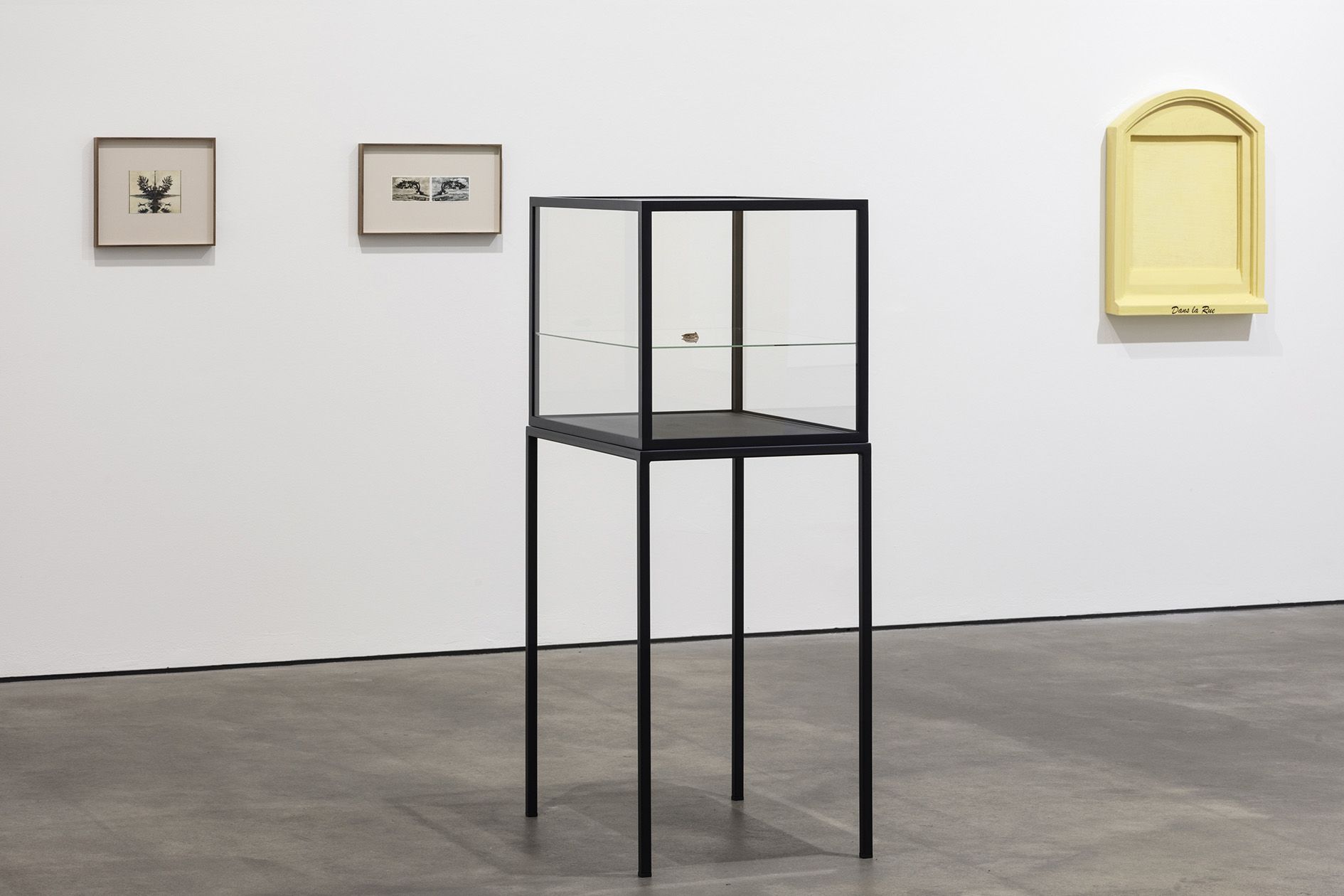

Andreas Slominski
Ich esse kein Papier, 2020
Bread, paper
8 cm × 5 cm × 1,5 cm
Encased within a black steel and glass vitrine, Andreas Slominski’s Ich esse kein Papier (2020) is the small scrap of bread left over with its rice paper label, suspended on a glass shelf. Made with limited means and with a product that has become increasingly valuable and cherished during the pandemic, the reserved piece of bread and its title allude to the absurdity of the practice of pasting on these little labels, now preserved as a testament to who left it behind.

Andreas Slominski
Ich esse kein Papier, 2020
Bread, paper
8 cm × 5 cm × 1,5 cm
Andreas Slominski
Ich esse kein Papier, 2020
Bread, paper
8 cm × 5 cm × 1,5 cm
Encased within a black steel and glass vitrine, Andreas Slominski’s Ich esse kein Papier (2020) is the small scrap of bread left over with its rice paper label, suspended on a glass shelf. Made with limited means and with a product that has become increasingly valuable and cherished during the pandemic, the reserved piece of bread and its title allude to the absurdity of the practice of pasting on these little labels, now preserved as a testament to who left it behind.
A mirror or window in a dull, yellow-glazed ceramic form, Rosemarie Trockel’s Dans la Rue (2019) is a cartoon-esque object that looks straight out of a fairy tale or film set. The title along its sill appears like a cheap slogan—or is it a reference to the French gilets jaunes protests? Seemingly obstinate, the wall-mounted sculpture presents itself to the viewer as an inaccessible window.
The work was displayed in the installation Group of Articles at the 2019 Venice Biennale, in the perhaps somewhat forebodingly titled exhibition May you live in interesting times.

Rosemarie Trockel
Dans la Rue, 2019
Ceramics, glazed, velvet
85 × 63 × 10 cm
33 1/2 × 24 7/8 × 4 inches
Edition 1 + 1 AP

Rosemarie Trockel
Dans la Rue, 2019
Ceramics, glazed, velvet
85 × 63 × 10 cm
33 1/2 × 24 7/8 × 4 inches
Edition 1 + 1 AP

Rosemarie Trockel
Dans la Rue, 2019
Ceramics, glazed, velvet
85 × 63 × 10 cm
33 1/2 × 24 7/8 × 4 inches
Edition 1 + 1 AP

May You Live in Interesting Times – 58th International Art Exhibition Installation view, La Biennale di Venezia, Venice, 2019

Rosemarie Trockel
Dans la Rue, 2019
Ceramics, glazed, velvet
85 × 63 × 10 cm
33 1/2 × 24 7/8 × 4 inches
Edition 1 + 1 AP
Rosemarie Trockel
Dans la Rue, 2019
Ceramics, glazed, velvet
85 × 63 × 10 cm
33 1/2 × 24 7/8 × 4 inches
Edition 1 + 1 AP


Rosemarie Trockel
Dans la Rue, 2019
Ceramics, glazed, velvet
85 × 63 × 10 cm
33 1/2 × 24 7/8 × 4 inches
Edition 1 + 1 AP
Rosemarie Trockel
Dans la Rue, 2019
Ceramics, glazed, velvet
85 × 63 × 10 cm
33 1/2 × 24 7/8 × 4 inches
Edition 1 + 1 AP


Rosemarie Trockel
Dans la Rue, 2019
Ceramics, glazed, velvet
85 × 63 × 10 cm
33 1/2 × 24 7/8 × 4 inches
Edition 1 + 1 AP


May You Live in Interesting Times – 58th International Art Exhibition Installation view, La Biennale di Venezia, Venice, 2019
A mirror or window in a dull, yellow-glazed ceramic form, Rosemarie Trockel’s Dans la Rue (2019) is a cartoon-esque object that looks straight out of a fairy tale or film set. The title along its sill appears like a cheap slogan—or is it a reference to the French gilets jaunes protests? Seemingly obstinate, the wall-mounted sculpture presents itself to the viewer as an inaccessible window.
The work was displayed in the installation Group of Articles at the 2019 Venice Biennale, in the perhaps somewhat forebodingly titled exhibition May you live in interesting times.

Tacita Dean
A Rakish Pair, 2020
Two found postcards, one painted with gouache
35 × 39 cm (framed)
13 7/8 × 15 3/8 inches (framed)

Tacita Dean
A Rakish Pair, 2020
Two found postcards, one painted with gouache
35 × 39 cm (framed)
13 7/8 × 15 3/8 inches (framed)

Tacita Dean
A Rakish Pair, 2020 (detail)

Tacita Dean
A Rakish Pair, 2020 (detail)

Tacita Dean
Sentinel, 2020
Two found postcards, one painted with gouache
30.5 × 49 cm (framed)
12 × 19 1/4 inches (framed)

Tacita Dean
Sentinel, 2020
Two found postcards, one painted with gouache
30.5 × 49 cm (framed)
12 × 19 1/4 inches (framed)

Tacita Dean
Sentinel, 2020 (detail)

Tacita Dean
Sentinel, 2020 (detail)

Tacita Dean
A Rakish Pair, 2020
Two found postcards, one painted with gouache
35 × 39 cm (framed)
13 7/8 × 15 3/8 inches (framed)
Tacita Dean
A Rakish Pair, 2020
Two found postcards, one painted with gouache
35 × 39 cm (framed)
13 7/8 × 15 3/8 inches (framed)


Tacita Dean
A Rakish Pair, 2020
Two found postcards, one painted with gouache
35 × 39 cm (framed)
13 7/8 × 15 3/8 inches (framed)


Tacita Dean
A Rakish Pair, 2020 (detail)


Tacita Dean
A Rakish Pair, 2020 (detail)

Tacita Dean
Sentinel, 2020
Two found postcards, one painted with gouache
30.5 × 49 cm (framed)
12 × 19 1/4 inches (framed)
Tacita Dean
Sentinel, 2020
Two found postcards, one painted with gouache
30.5 × 49 cm (framed)
12 × 19 1/4 inches (framed)


Tacita Dean
Sentinel, 2020
Two found postcards, one painted with gouache
30.5 × 49 cm (framed)
12 × 19 1/4 inches (framed)


Tacita Dean
Sentinel, 2020 (detail)


Tacita Dean
Sentinel, 2020 (detail)
The diptychs A Rakish Pair and Sentinel (both 2020) by Tacita Dean present found postcards alongside mirroring paintings, each painstakingly depicting trees that have grown crooked. The now symmetrical images also resemble Rorschach tests, creating associative, open-ended abstractions from natural forms.
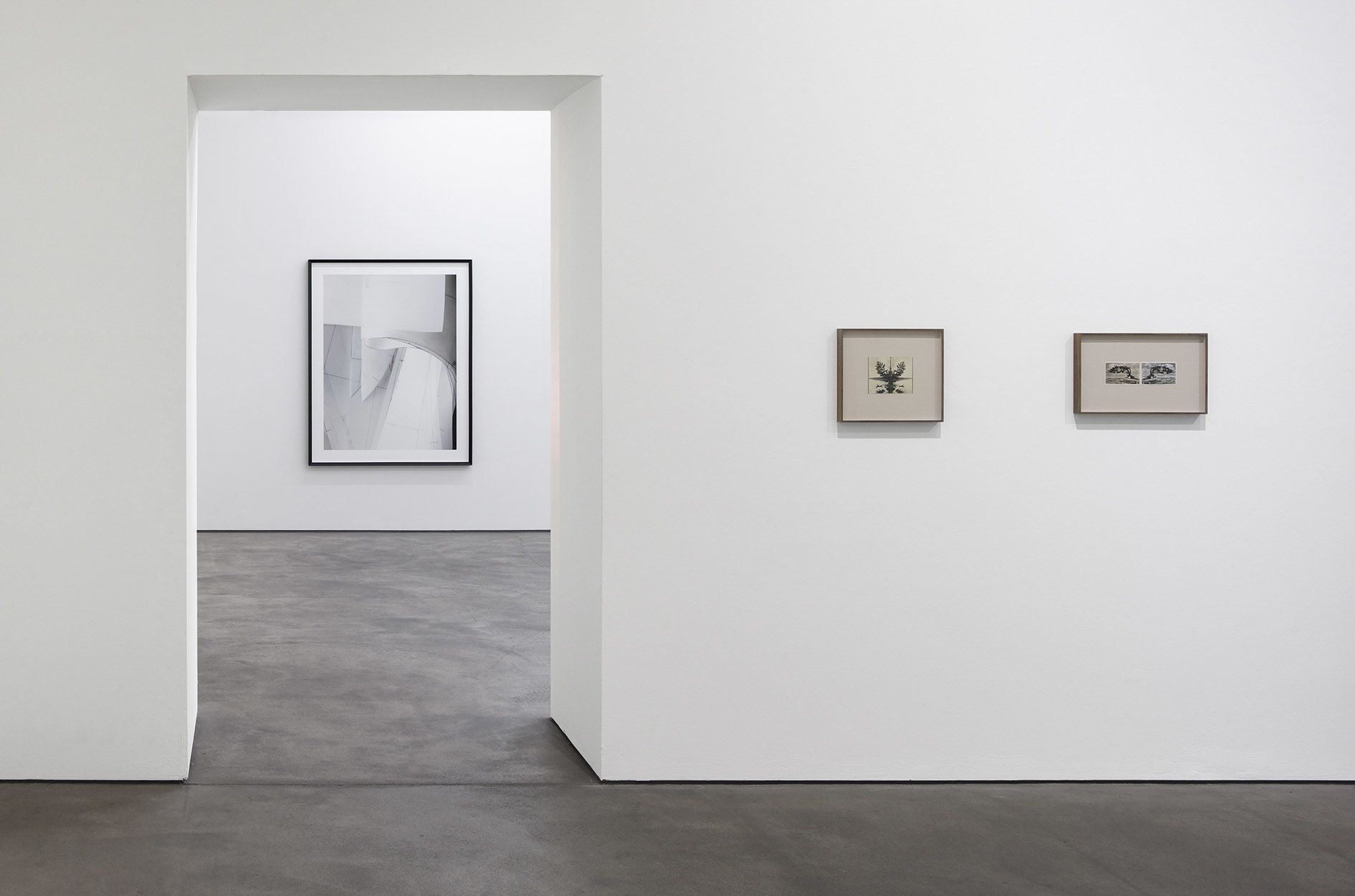

Thomas Demand
blackcap, 2020
Framed pigment print
145 × 110 cm
57 × 43 1/4 inches
Edition of 2
As a continuation of Thomas Demand’s Model Studies series, blackcap (2020) depicts a pattern in the studio of the late couturier Azzedine Alaïa. As a photograph of a drawing, the work is closely concerned with line and shade, depicted well over life-size. Demand’s exacting work methods dictate that the pigment print is produced only at a specialist printers in America he got to know whilst living in the US—a global process that has become increasingly difficult in the current situation.
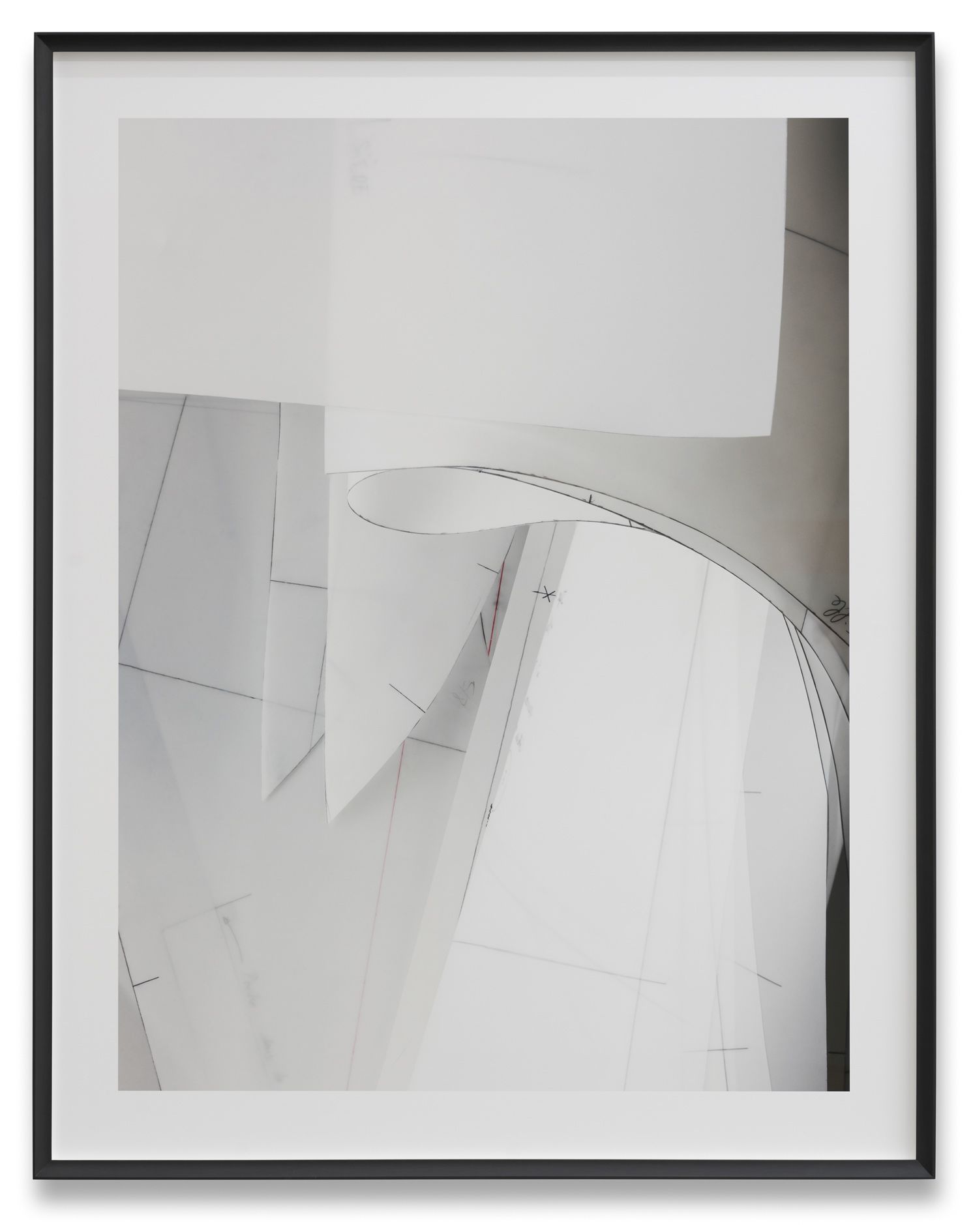
Thomas Demand
blackcap, 2020
Framed pigment print
145 × 110 cm
57 × 43 1/4 inches
Edition of 2
Thomas Demand
blackcap, 2020
Framed pigment print
145 × 110 cm
57 × 43 1/4 inches
Edition of 2
As a continuation of Thomas Demand’s Model Studies series, blackcap (2020) depicts a pattern in the studio of the late couturier Azzedine Alaïa. As a photograph of a drawing, the work is closely concerned with line and shade, depicted well over life-size. Demand’s exacting work methods dictate that the pigment print is produced only at a specialist printers in America he got to know whilst living in the US—a global process that has become increasingly difficult in the current situation.
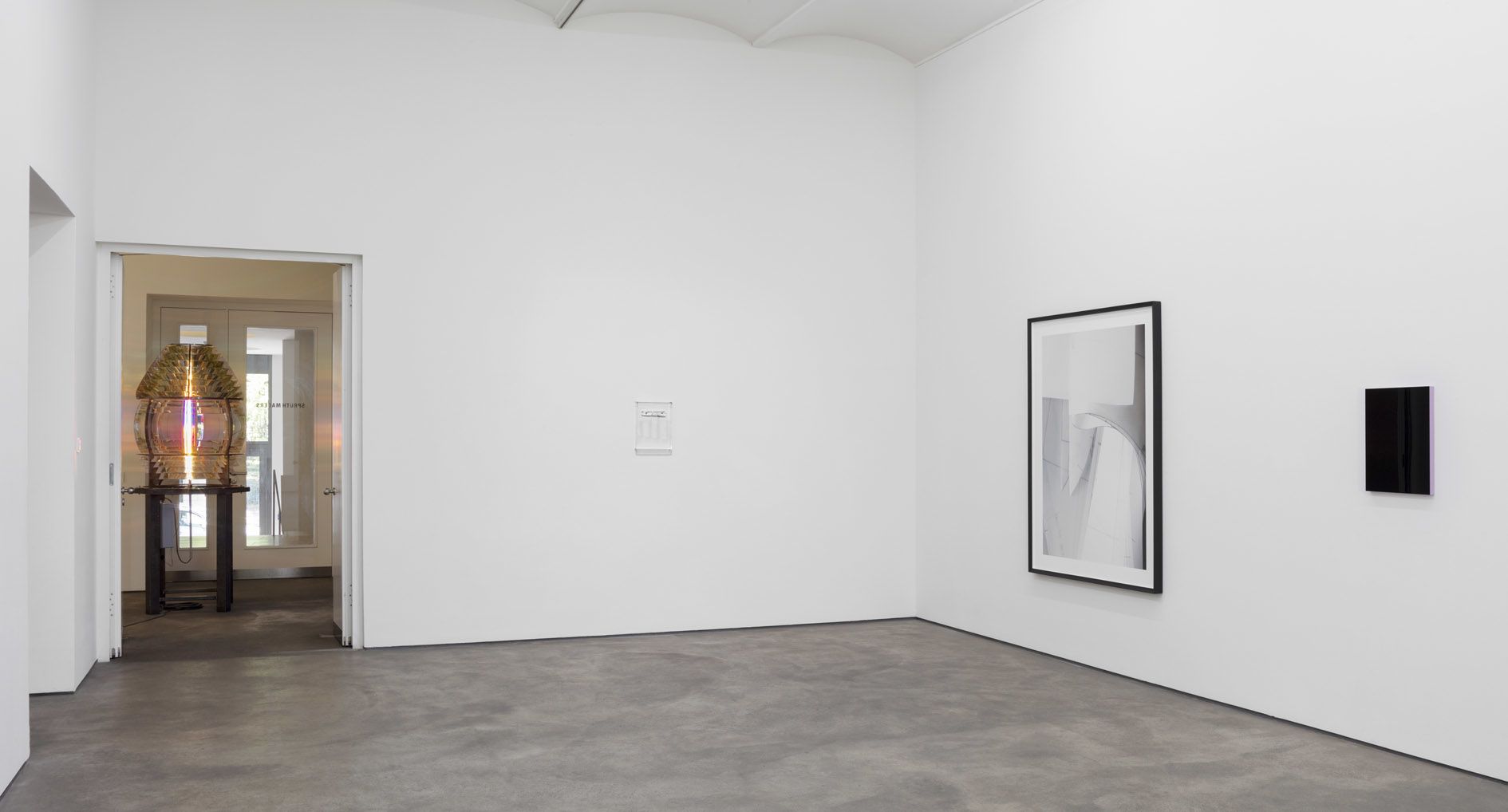
Ceal Floyer’s Untitled (Remainder) (2020) presents a small wedge of plastic, the vestige of a stack of plastic bags, typically found in shops for fresh produce, that have all been torn off and used. The viewer seems to have arrived late: there are no sacks left, perhaps as a result of the panic buying that took place at the start of the pandemic, leaving only a sense of emptiness and vulnerability.

Ceal Floyer
Untitled (Remainder), 2020
Polythene, metal hooks, acrylic cover
33 × 25 × 4.5 cm (framed)
13 × 9 7/8 × 1 3/4 inches (framed)
Edition of 3 + 2 AP

Ceal Floyer
Untitled (Remainder), 2020
Polythene, metal hooks, acrylic cover
33 × 25 × 4.5 cm (framed)
13 × 9 7/8 × 1 3/4 inches (framed)
Edition of 3 + 2 AP

Ceal Floyer
Untitled (Remainder), 2020
Polythene, metal hooks, acrylic cover
33 × 25 × 4.5 cm (framed)
13 × 9 7/8 × 1 3/4 inches (framed)
Edition of 3 + 2 AP
Ceal Floyer
Untitled (Remainder), 2020
Polythene, metal hooks, acrylic cover
33 × 25 × 4.5 cm (framed)
13 × 9 7/8 × 1 3/4 inches (framed)
Edition of 3 + 2 AP


Ceal Floyer
Untitled (Remainder), 2020
Polythene, metal hooks, acrylic cover
33 × 25 × 4.5 cm (framed)
13 × 9 7/8 × 1 3/4 inches (framed)
Edition of 3 + 2 AP
Ceal Floyer’s Untitled (Remainder) (2020) presents a small wedge of plastic, the vestige of a stack of plastic bags, typically found in shops for fresh produce, that have all been torn off and used. The viewer seems to have arrived late: there are no sacks left, perhaps as a result of the panic buying that took place at the start of the pandemic, leaving only a sense of emptiness and vulnerability.

Omer Fast
Beckmann’s Rope, 2020
Video on mobile phone
14.6 × 7.2 × 0.8 cm
5 3/4 × 2 7/8 × 1/4 inches
Edition of 6
Presented on a mobile phone left on the floor, Beckmann’s Rope (2020) by Omer Fast makes reference to a diptych by Max Beckmann that depicts a number of figures in the same predicament. They are tied to each other top to tail with rope, in their own isolation union. Originally conceived as a performance for a since cancelled exhibition, the work shows a rehearsal and takes on a different life as a video work presented in this format.

Omer Fast
Beckmann’s Rope, 2020
Video on mobile phone
14.6 × 7.2 × 0.8 cm
5 3/4 × 2 7/8 × 1/4 inches
Edition of 6
Omer Fast
Beckmann’s Rope, 2020
Video on mobile phone
14.6 × 7.2 × 0.8 cm
5 3/4 × 2 7/8 × 1/4 inches
Edition of 6
Presented on a mobile phone left on the floor, Beckmann’s Rope (2020) by Omer Fast makes reference to a diptych by Max Beckmann that depicts a number of figures in the same predicament. They are tied to each other top to tail with rope, in their own isolation union. Originally conceived as a performance for a since cancelled exhibition, the work shows a rehearsal and takes on a different life as a video work presented in this format.

Omer Fast
Cluster #5, 2020
Cherry pits, styrofoam, wood
19.5 × 31 × 31 cm
7 3/4 × 12 1/8 × 12 1/8 inches

Omer Fast
Cluster #5, 2020
Cherry pits, styrofoam, wood
19.5 × 31 × 31 cm
7 3/4 × 12 1/8 × 12 1/8 inches
Omer Fast
Cluster #5, 2020
Cherry pits, styrofoam, wood
19.5 × 31 × 31 cm
7 3/4 × 12 1/8 × 12 1/8 inches
What appears to be an invasive wasps’ nest assembled in the corner of the room is on closer inspection in fact a facsimile made from cherry stones. Omer Fast made Cluster #5 (2020) during isolation with his family as the cherry season arrived in early summer. Making use of what was immediately available as a form of occupational therapy, the work forms part of a series that also makes use of discarded packaging materials.

Akinori Tao
A measure of life, 2019
Polyurethane, silicone, clay, ink, glass bowls
Dimensions variable
Installation dimensions at Sprüth Magers, Berlin:
4.5 × 26.5 × 10.5 cm
Dimensions variable
Installation dimensions at Sprüth Magers, Berlin:
1 3/4 × 10 3/8 × 4 1/8 inches

Akinori Tao
A measure of life, 2019
Polyurethane, silicone, clay, ink, glass bowls
Dimensions variable
Installation dimensions at Sprüth Magers, Berlin:
4.5 × 26.5 × 10.5 cm
Dimensions variable
Installation dimensions at Sprüth Magers, Berlin:
1 3/4 × 10 3/8 × 4 1/8 inches
Akinori Tao
A measure of life, 2019
Polyurethane, silicone, clay, ink, glass bowls
Dimensions variable
Installation dimensions at Sprüth Magers, Berlin:
4.5 × 26.5 × 10.5 cm
Dimensions variable
Installation dimensions at Sprüth Magers, Berlin:
1 3/4 × 10 3/8 × 4 1/8 inches
A small, fluttering moth appears to be drowning in a glass bowl of milk, while an adjacent bowl mysteriously echoes the same ripples in the liquid. Titled Ein Maß des Lebens (A Measure of Life) (2019), Akinori Tao’s surreal mise-en-scène, placed on a windowsill, underscores the current predicament of being trapped inside, while also making reference to the butterfly effect, which states that a small impulse on one side of the globe can create a massive impact for the rest of it.
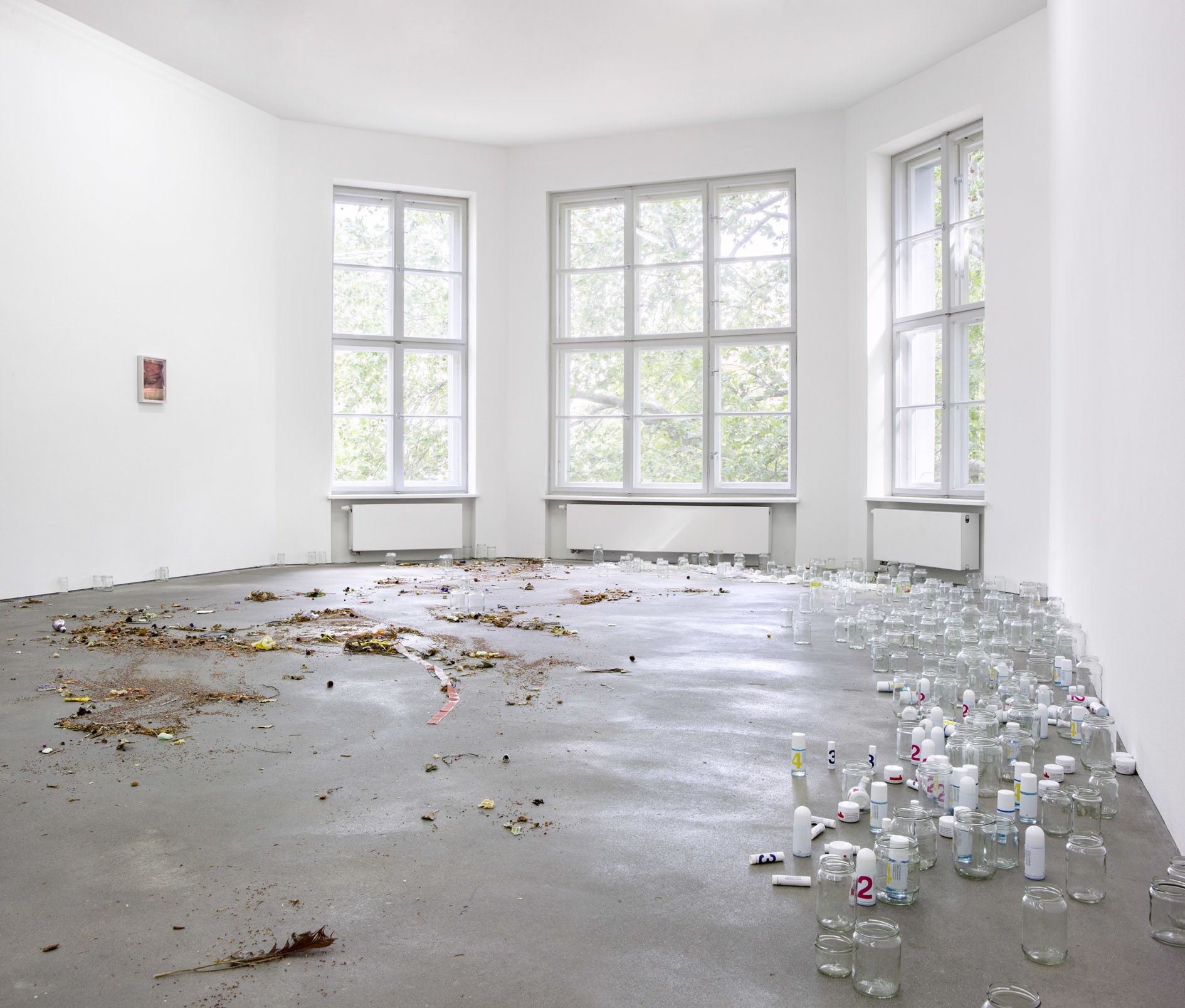
Jason Dodge’s installation, comprised of various small objects, glass jars, bottles of cosmetic products and general dust and detritus, concerns itself with the violence of mass production and consumption. Referring throughout to what goes into, onto and is shed by the body, the glass receptacles could read the product of hoarding or as canopic jars (used by the Egyptians for the preservation of viscera). With a morbid sense of loss pervading the work, the artist left it purposefully untitled.
Ketuta Alexi-Meshkhishvili’s photographic prints Hujar’s hand on Motherhood, Blue Rose Aldi Tüte and Pink Anthurium Pharynx (all 2020) bring a certain mysticism to the artifacts of everyday life. With each object and print triggering a range of poetic associations, enhanced by the use of transparent layers that lend the whole composition a certain dream-like aesthetic, they evoke an elegiac mood.

Ketuta Alexi-Meskhishvili
Hujar’s hand on Motherhood, 2020
Two archival pigment prints on screen film in a box frame
30.6 × 22.7 cm
12 × 9 inches
Edition of 2 + 2 AP

Ketuta Alexi-Meskhishvili
Blue Rose Aldi Tüte, 2020
Two archival pigment prints on screen film in a box frame
30.6 × 22.7 cm
12 × 9 inches
Edition of 2 + 2 AP

Ketuta Alexi-Meskhishvili
Pink Anthurium Pharynx, 2020
Two archival pigment prints on screen film in a box frame
30.6 × 22.7 cm
12 × 9 inches
Edition of 2 + 2 AP

Ketuta Alexi-Meskhishvili
Hujar’s hand on Motherhood, 2020
Two archival pigment prints on screen film in a box frame
30.6 × 22.7 cm
12 × 9 inches
Edition of 2 + 2 AP
Ketuta Alexi-Meskhishvili
Hujar’s hand on Motherhood, 2020
Two archival pigment prints on screen film in a box frame
30.6 × 22.7 cm
12 × 9 inches
Edition of 2 + 2 AP

Ketuta Alexi-Meskhishvili
Blue Rose Aldi Tüte, 2020
Two archival pigment prints on screen film in a box frame
30.6 × 22.7 cm
12 × 9 inches
Edition of 2 + 2 AP
Ketuta Alexi-Meskhishvili
Blue Rose Aldi Tüte, 2020
Two archival pigment prints on screen film in a box frame
30.6 × 22.7 cm
12 × 9 inches
Edition of 2 + 2 AP

Ketuta Alexi-Meskhishvili
Pink Anthurium Pharynx, 2020
Two archival pigment prints on screen film in a box frame
30.6 × 22.7 cm
12 × 9 inches
Edition of 2 + 2 AP
Ketuta Alexi-Meskhishvili
Pink Anthurium Pharynx, 2020
Two archival pigment prints on screen film in a box frame
30.6 × 22.7 cm
12 × 9 inches
Edition of 2 + 2 AP
Ketuta Alexi-Meshkhishvili’s photographic prints Hujar’s hand on Motherhood, Blue Rose Aldi Tüte and Pink Anthurium Pharynx (all 2020) bring a certain mysticism to the artifacts of everyday life. With each object and print triggering a range of poetic associations, enhanced by the use of transparent layers that lend the whole composition a certain dream-like aesthetic, they evoke an elegiac mood.
In its depiction of an airport terminal, Corinne Wasmuht’s large and complex painting DJ ZV (1) titanium dioxide (2020) offers a fragmentary interpretation of the balance between illusory and real space. With the connotations and familiarity of airports recently undergoing considerable change, the work takes on a different contemporary resonance, even more noticeable as the painting was slowly worked on over years to be finished after the topic depicted changed its iconological status.

Corinne Wasmuht
DJ ZV (1) titanium dioxide, 2020
Oil on wood
244 × 255 cm
96 × 100 3/8 inches
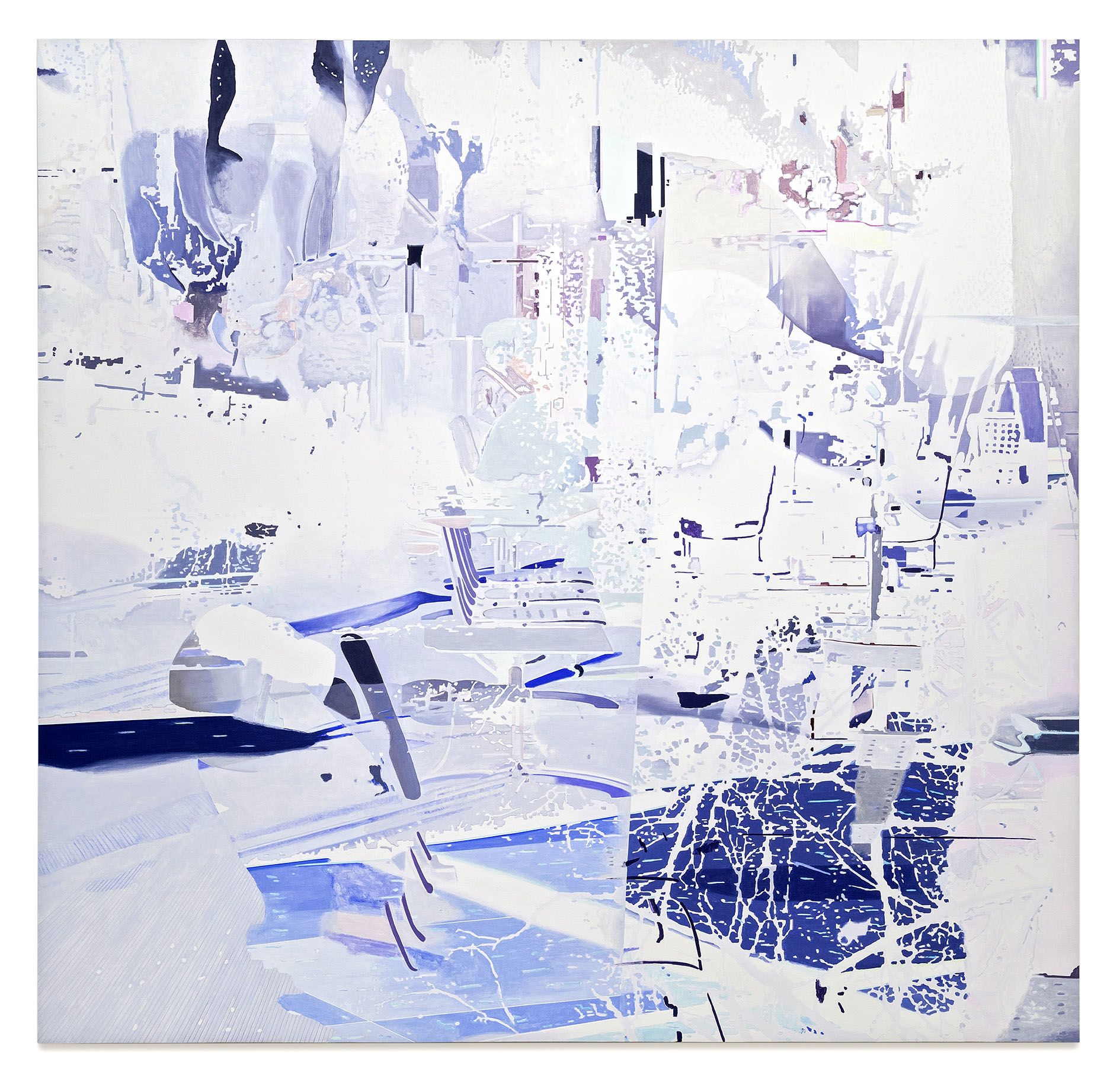
Corinne Wasmuht
DJ ZV (1) titanium dioxide, 2020
Oil on wood
244 × 255 cm
96 × 100 3/8 inches
Corinne Wasmuht
DJ ZV (1) titanium dioxide, 2020
Oil on wood
244 × 255 cm
96 × 100 3/8 inches
All installation views: Ingo Kniest and Timo Ohler